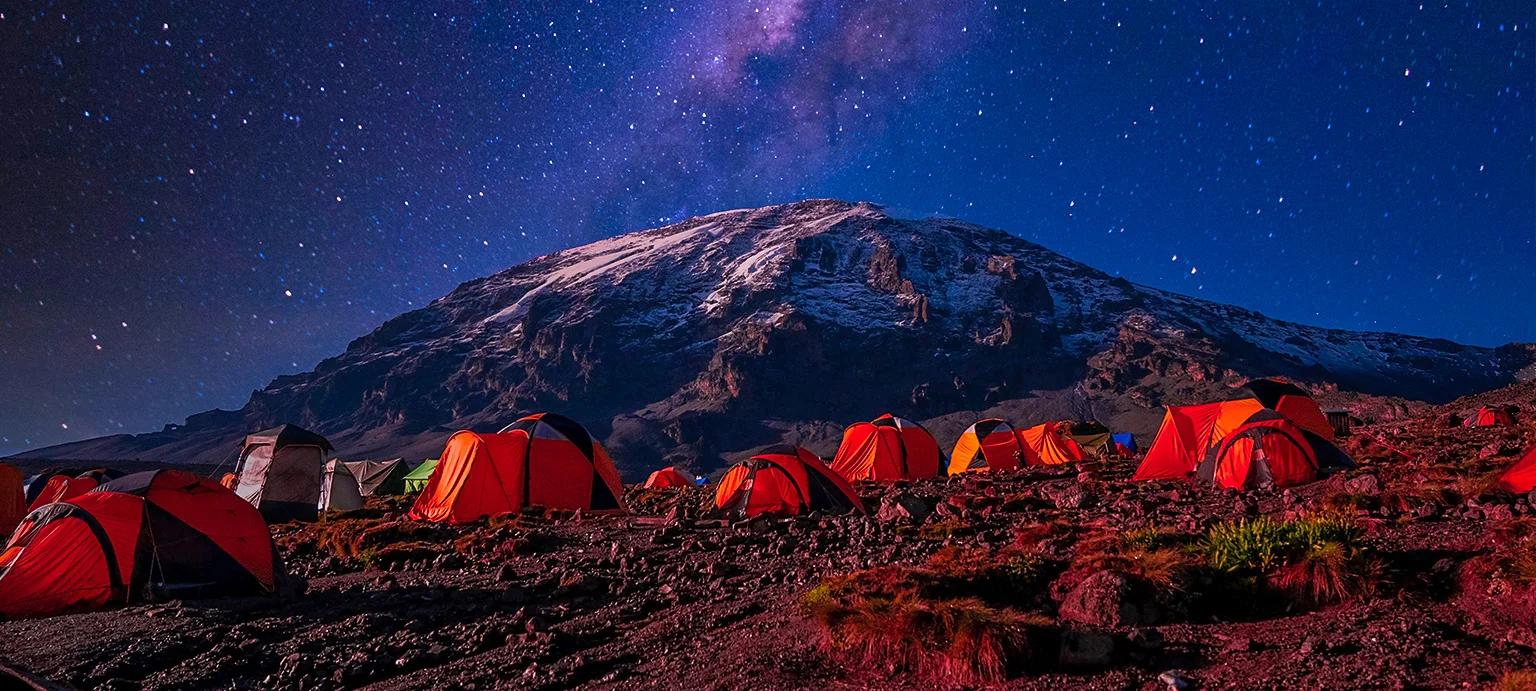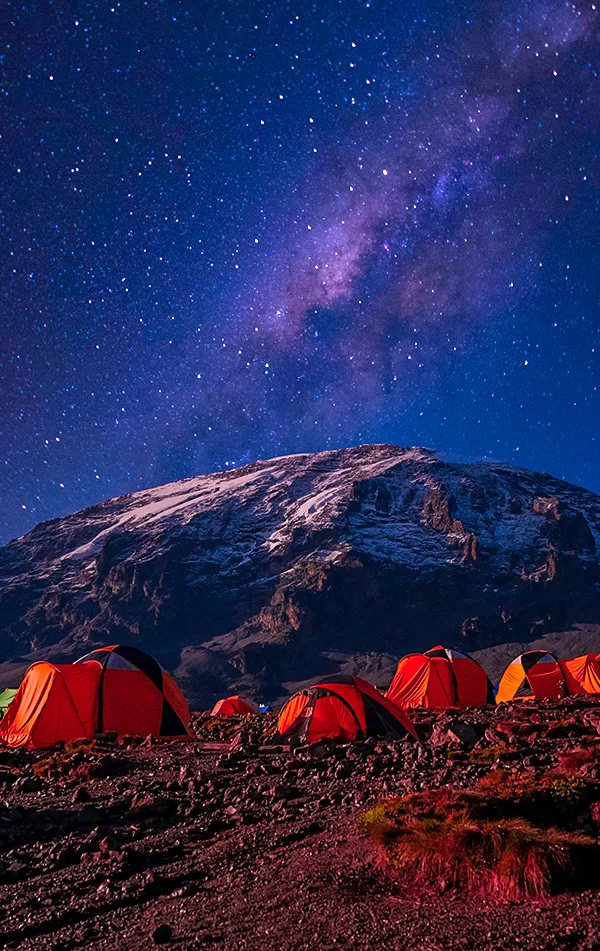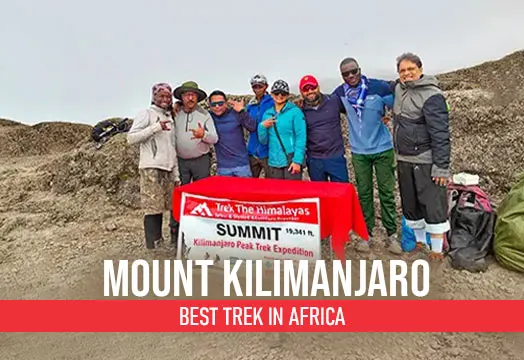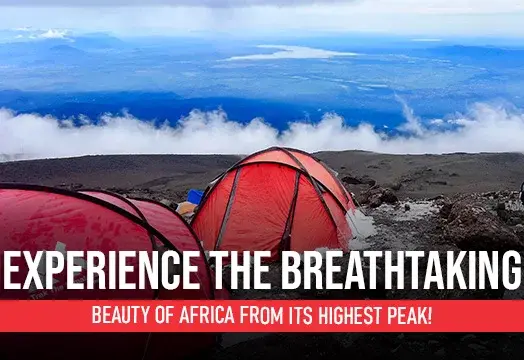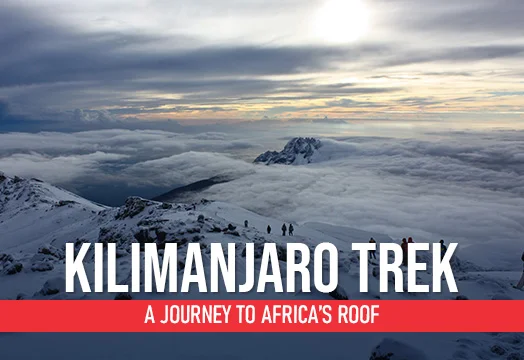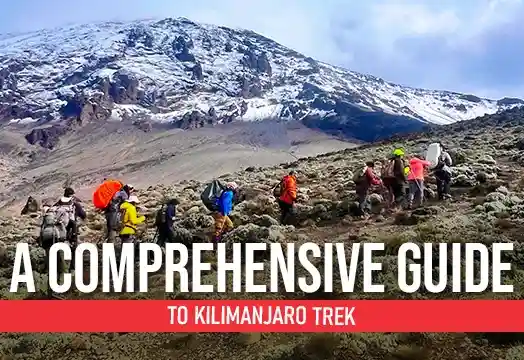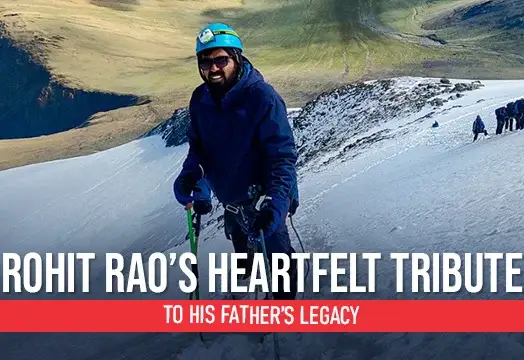Mount Kilimanjaro Trek

Region
Tanzania | Tanzania | Africa

Duration
9 Days

Max Altitude
19350 Ft.

Trekking Km
66 KM

Grade
Moderate to Difficult
Get in Touch with Our Trek Expert
91 9368882322 info@trekthehimalayas.comMonday - Saturday: 10 AM to 09.30 PM (GMT +5:30)
Sunday: 10 AM to 05.30 PM (GMT +5:30)
225000 /Person
- August-2026
- October-2026
- December-2026
- 5% GST will be applicable on Trek Cost and Add-ons
- Services from Kilimanjaro International Airport to the Airport.
- 1:1 ratio of guides to trekkers on the summit day.
- Included a porter to carry personal luggage up to 15 kg.
Get in Touch with Our Trek Expert
91 9368882322info@trekthehimalayas.com
Monday - Saturday: 10 AM to 06 PM (GMT +5:30)
Overview
Trek Name: Mount Kilimanjaro Trek
Days: 9
Adventure Type: Trekking
Base Camp: Moshi
Season:Spring | Summer | Monsoon | Autumn | Winter |
Month:January | August | October |
Country: Tanzania | Africa
Altitude: 19350 Ft.
Grade: Moderate to Difficult
Rail Head: -
Stay: Camping & Hotel/Guesthouse (Twin sharing)
Food: .
Location: Tanzania
Distance: 66 Km.
Trail Type: Summit, Point to point | Scale a peak, Camping at the same location upon returning.
AirPort: Kilimanjaro International Airport
Highlights:
- 5% GST will be applicable on Trek Cost and Add-ons
- Services from Kilimanjaro International Airport to the Airport.
- 1:1 ratio of guides to trekkers on the summit day.
- Included a porter to carry personal luggage up to 15 kg.
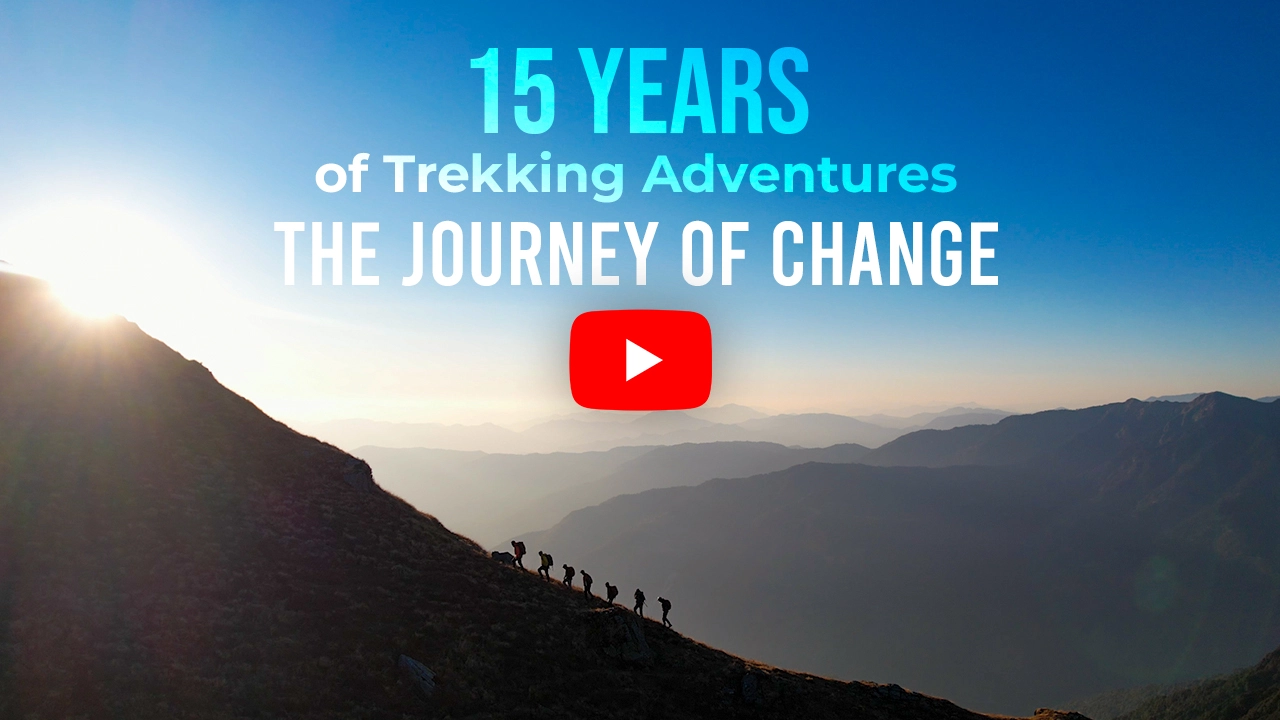
Why is Mount Kilimanjaro a Must- do Trek?
- Mount Kilimanjaro counts as one of the Seven Summits of the world, and it is the most accessible among them.
- It is called the Roof of Africa, as you stand at its top and witness stunning views of African cities below.
- You walk through different terrains, including lush forests, moorlands, alpine deserts, and the glacial summit zone.
- You experience changes in climate as you ascend, tropical warmth at the base, misty cloud forests mid-way, and icy winds with snowfall at the top. It feels like walking through nature’s extreme moods.
- Though it requires no mountaineering skills, the trek includes thrilling sections like the Barranco Wall, adding exciting moments to the journey.
- The sunsets during the trek are truly beautiful, especially from the Karanga campsite, where you get the best sunset view.
- The nights are spent under a sky full of bright stars, while the city lights below shine like stars too.
- You meet wonderful locals and enrich your journey while learning and growing through the entire experience.
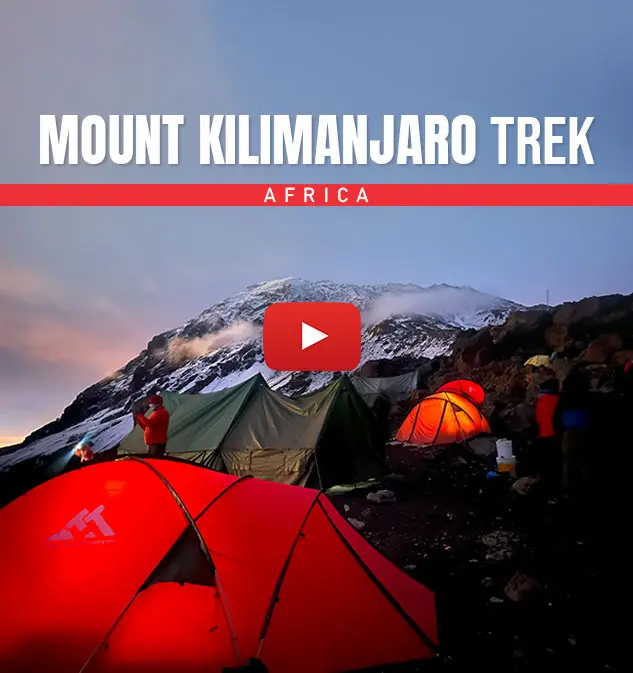
Who Can Participate
- Age Requirement:
- April to November: 14 years.
- December to March: 16 years.
- First-timers are welcome, though prior trekking experience is preferred. Good fitness is a must.
- Fitness Criteria:
- If the trekker wants to carry a backpack then he/she should be able to carry a 10-12 kg backpack. If opt Off-load option then the trekker should be able to carry 3-5 kg backpack.
- If a trekker's BMI is more or less than the normal range (18-27), please consult our Trek Coordinator before booking.
Mount Kilimanjaro Trek Itinerary
Kilimanjaro International Airport To Moshi
- Arrive: at Kilimanjaro Airport.
- Stay: at a Resort in Moshi.
- Altitude (Moshi): 800 m.
- Airport to Moshi: 42 km | 1 hour.
- Pre-climb briefing: and equipment check in the evening.
- Explore: the city or relax today.
On your arrival, you will meet a TTH representative standing just outside the Kilimanjaro International Airport as per your flight booking. You will easily spot him holding a TTH banner in his hands. He will take you right away to the booked hotel-cum-resort in Moshi. The distance from the airport to Moshi is approximately 42 km and it takes around 1 hour to get there. On reaching the hotel, just check-in and relax. At 5:30 PM (local time), there will be an important meeting with our Trek Leader. He will give you a crucial pre-climb briefing and equipment check as per the climbing gear list. This meeting is also helpful regarding any last minute gear requests. Once you are properly briefed, you can either explore the city or relax at the resort.
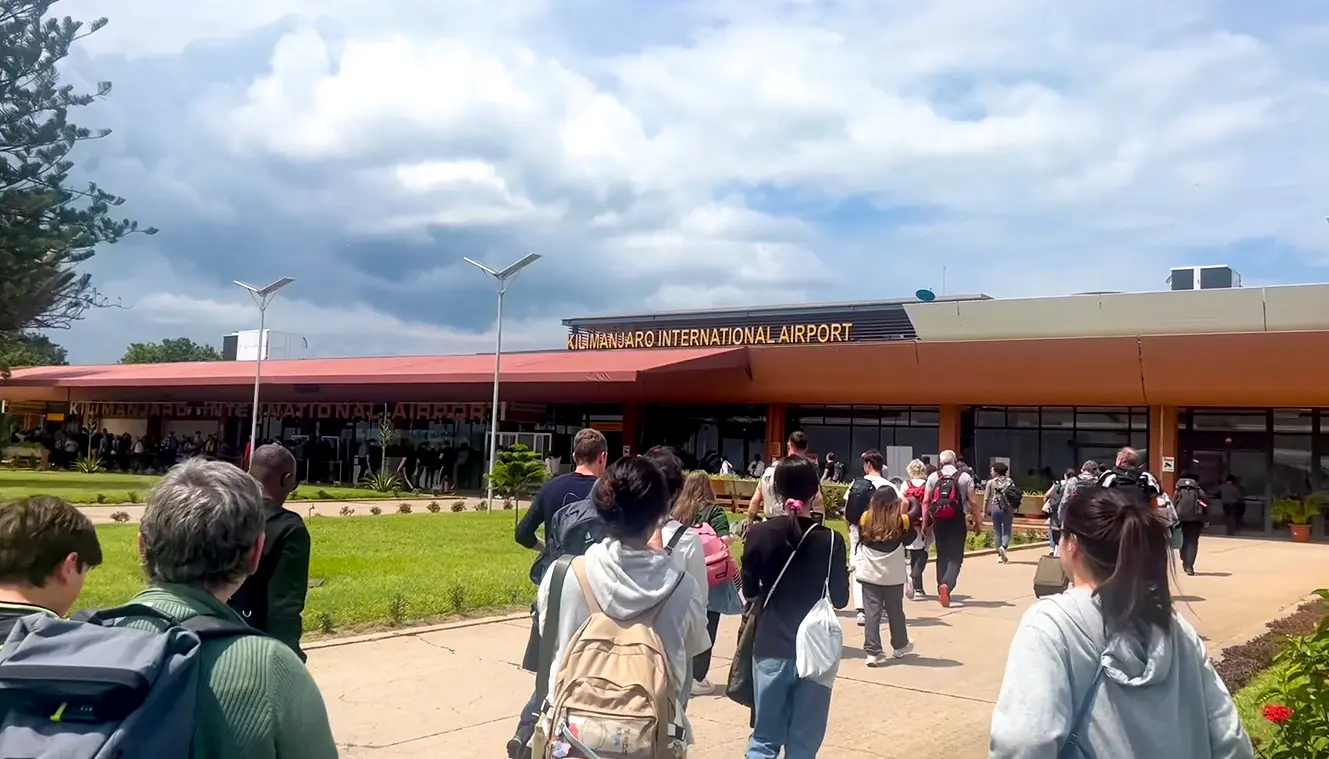
Drive to Machame Gate and trek to Machame camp
- Drive distance (Moshi to Machame gate): 31 km.
- Drive time: 1 hr.
- Altitude (Machame gate): 1,800 m, (Machame Camp): 3,000 m.
- Trek Distance: 11 km.
- Hiking Time: 5 - 6 hrs.
- Elevation Gain: 1,200 m.
- Habitat: Montane Forest.
- Accommodation: Machame camp.
In the morning of day -2, you have to be ready for registration and then your journey begins from here. Excitement builds as the porters load up equipment and you will meet the trekking team that will accompany you throughout your trekking expedition. You will get a drive from Moshi to Machame Gate, which is 31 km in distance and takes around 1 hr to reach there.
Machame Gate is located at an altitude of 1,800 m and this is where you will start your actual trek. You will start walking on the Machame – Mweka Route (normally referred to as the Machame Route), which will allow you to approach the mountain from south-western side. The second day’s destination is Machame Camp covering a distance of 11 km in 5 – 6 hours. The winding trail of this trek takes you through a dense forest of enchanting tall trees laden with green moss. As the route becomes steeper and narrower, the vegetation changes and the appearance of flowers such as Impatiens Kilimanjari and Impatiens Pseudoviola introduce some vibrancy to the scenery. Some of the trees in this cloud forest can reach up to 25 meters in height. Around 13:00 Hrs (local time), you will be provided picnic lunch and after refilling your water bottles, your hike begins again. The emblematic giant heathers appear as you reach heathland and the forest thins out here. Right here you get your first glimpse of Kibo peak. Machame Camp is reached at around 17.00 Hrs and you will be surprised by the richness of the birdlife here. Dinner is served at 19.30.
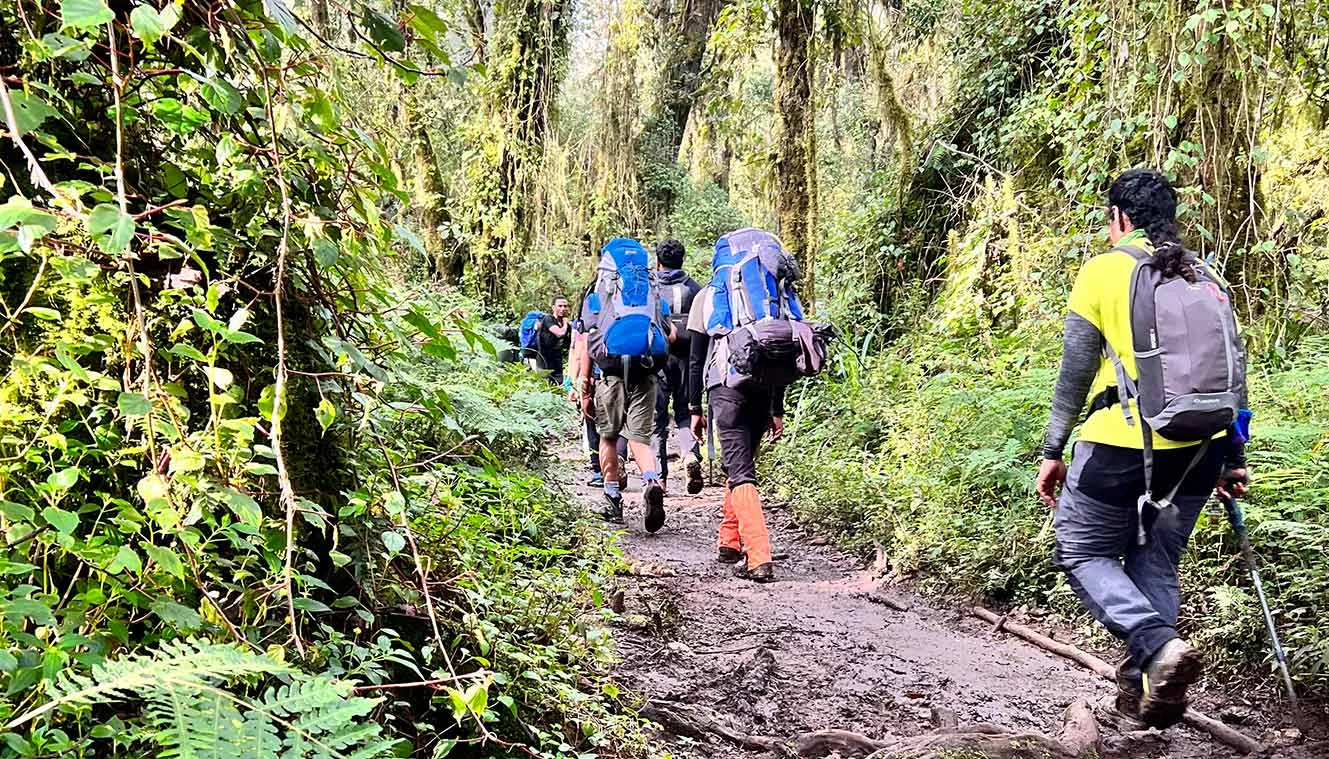
Machame Camp to Shira Camp
- Altitude (Machame Camp): 3000 m, (Shira Camp): 3,800 m.
- Trek Distance: 5–6 km.
- Trek Time: 4–5 hrs.
- Elevation Gain: 800 m.
- Habitat: Moorland.
- Full Board: Shira Cave Camp.
On day-3, after having breakfast at 07:00 am, you will leave for Shira Camp around 08:30 am. After achieving an elevation gain of 800 meters on this trek, you will finish the day’s hike at Shira Camp, located at an altitude of 3800 meters. The distance of this segment of the trek is 5-6 km, which is completed in 4 to 5 hours. The third day’s trail is dusty, narrow, and steep at some places. The vegetation is initially made up of forests of heather but soon you will encounter the first sight of the giant Groundsels. After a steep ascent somewhere around midday, you will be provided lunch and you will enjoy the meal with great views to the south and to Kibo. Because of the early start and short distance, you will reach the camp by 14:00 hrs. By this time, you will have seen Moorland Lobelias along with a distinctive dark obsidian rock of Shira Plateau for the first time. Once at the camp, you will have plenty of time to admire sights such as the so-called Shira Cathedral, Klute Peak, and Mount Meru. At around 18:00 hrs, you will be served your dinner.
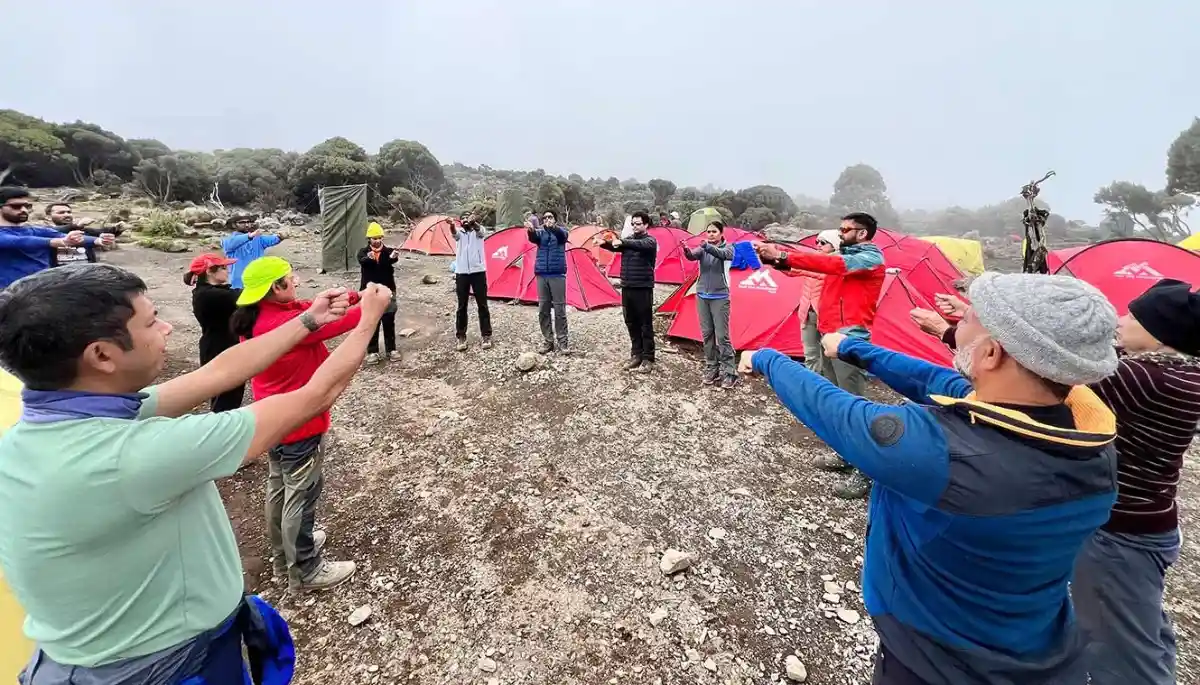
Shira Camp To Barranco Camp Via Lava Tower Camp
- Shira Cave Camp (3,800 m) to Barranco Camp (3,900 m) via Lava Tower Camp (4,600 m).
- Trek Distance: 10 km.
- Trek Time: 5–6 hrs.
- Elevation Gain: 100 m.
- Habitat: Moorland.
- Accommodation: Barranco Camp.
On day-4, with renewed excitement and a fresh start in the morning, you will leave for Barranco Camp at 08:30 hrs after breakfast as usual. Although the overall gain in altitude is 100 meters, you will walk to Lava Tower Camp first, which is located at a height of 4,600 m, and then descend to Barranco Camp to finish this day’s hike. The Lava Tower is a volcanic plug, leftover from the time when Mt. Kilimanjaro used to be an active volcano.
Your acclimatization skills will be beneficial for you on this trek as you climb high and then descend again for the overnight stop. The overall distance of around 10km means that you will actually be walking for around 5-6 hours, excluding breaks. Being a volcanic terrain, the vegetation on this trek is sparse with just a few hard lichens here and there. You climb towards the Lava Tower where the landscape gradually changes to rocky grounds and lava ridges. Although the climb is not very steep it is quite strenuous as your body adjusts to the lack of oxygen. Lunch will be served as usual at around 13:00 hrs and after passing Lava Tower, you descend to the Barranco Camp. The Barranco Valley was formed due to a massive landslide about a hundred thousand years ago and is surrounded on all sides by towering cliffs. You will have the first view of the Barranco Wall while descending towards the camp. At this pace, you are expected to reach the camp by 16:00 hrs. Once you get there, you will enjoy the views of the southern face of Kibo and Heim Glacier. The word “Barranco” means “deep ravine” or “gorge” in Spanish as this place lies in a valley. Dinner will be served at 19:00 hrs.
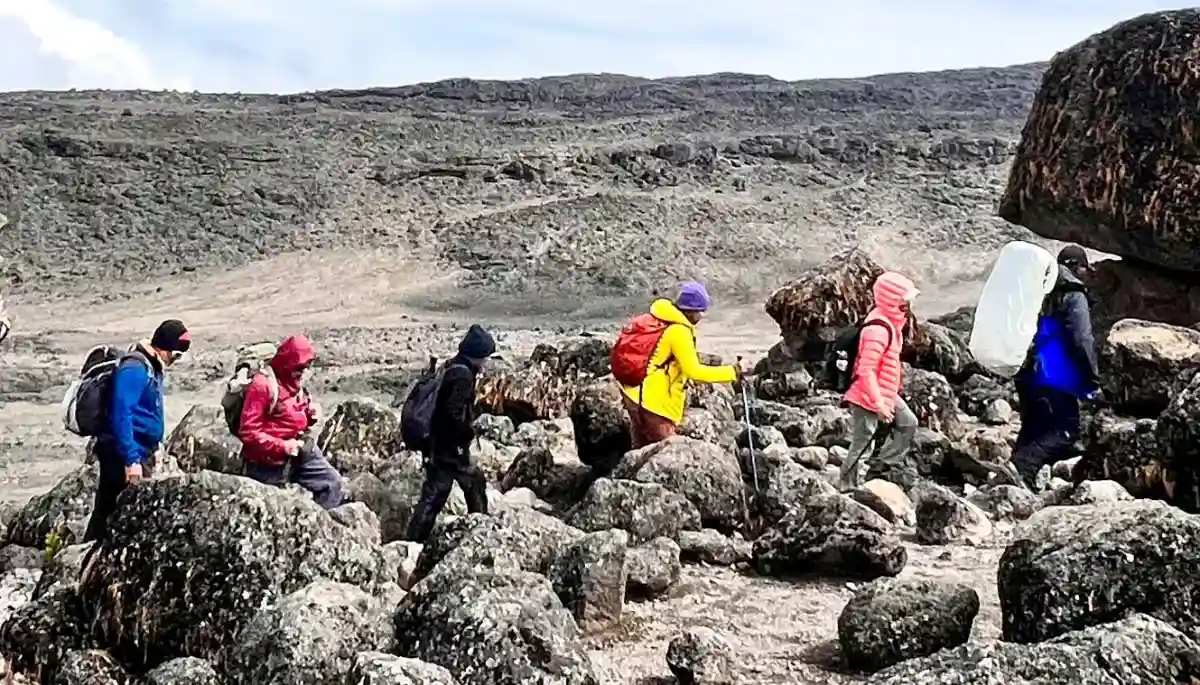
Barranco Camp To Karanga Camp
- Barranco Camp (3,900 m) to Karanga Camp (4,000 m).
- Trek Distance: 6 km.
- Trek Time: 4–5 hrs.
- Elevation Gain: 100 m.
- Habitat: Moorland.
- Accommodation: Karanga Camp.
On Day-5, you will have breakfast slightly later at 07:30 hrs, and then you will leave for Karanga Camp at 08:30 in the morning. Today, the distance to be covered is 6 km and it will take 4 to 5 hrs to complete. The altitude of Karanga Camp is 4,000 m, while the elevation gain is just 100 m. You will enjoy your hot lunch at 13:00 hrs after reaching Karanga Camp.
Then you’ll have enough time to enjoy your afternoon by sightseeing and other attractive views. Right at the beginning of the trek, you will go through a challenging hike as you have to scramble up the near-vertical face of Barranco Wall (also commonly referred to as the ‘Breakfast Wall’). The air is thin and the climb is steep which makes the initial hike quite strenuous. At the top of this climb, you will be rewarded with views of the Heim Glacier, which appears a lot closer now. After this, the rest of today’s walk becomes a bit easier as we first descend to the gully below, and into the cold and windy but beautiful Karanga Valley. This enchanting location also serves as a crucial acclimatization point for trekkers. This valley is predominantly replete with heath and moorland vegetation, rugged terrain and beautiful surrounding peaks. The campsite is on the opposite side of the valley that is reached by climbing up a steep series of zig-zag steps. Post-lunch, you can explore this area for exotic species such as shutterbugs and Malachite Sunbirds.
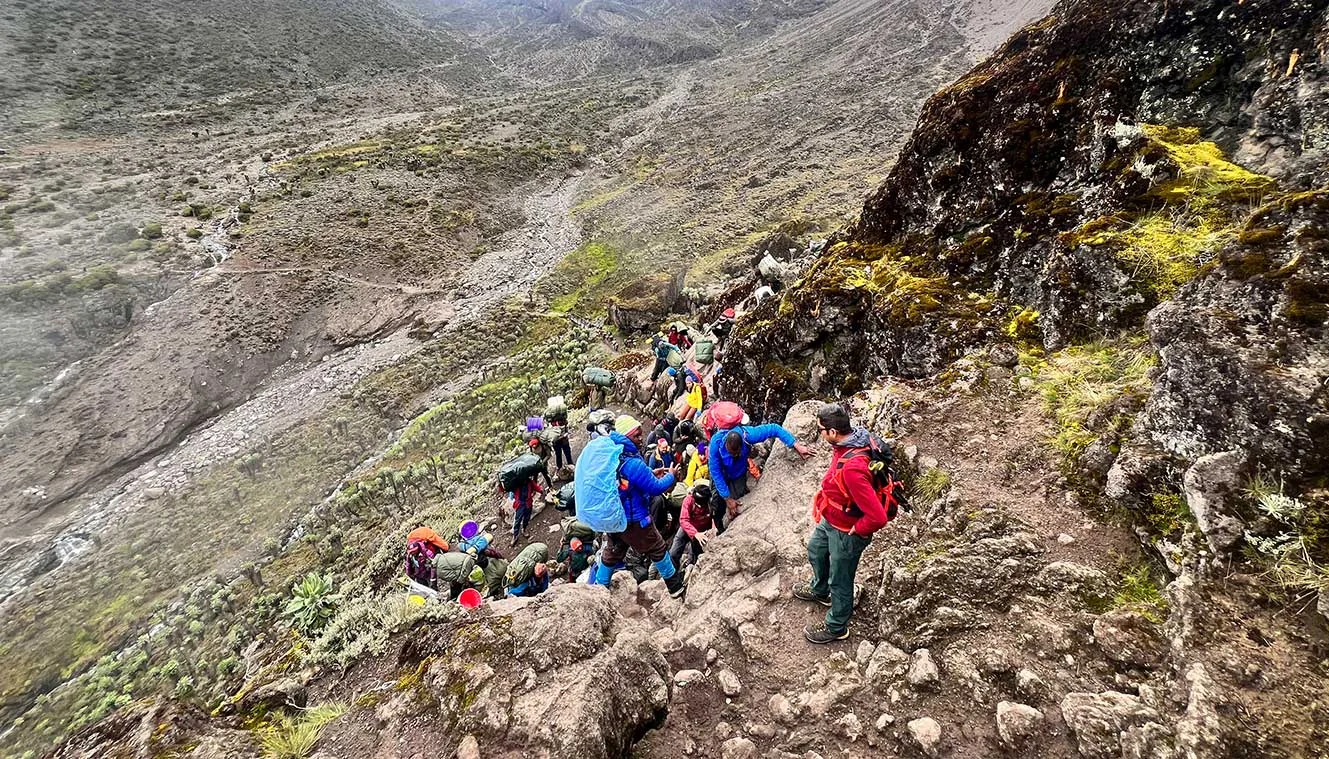
Karanga Camp To Barafu Camp
- Karanga Camp (4,000 m) to Barafu Camp (4,700 m).
- Trek Distance: 4 km.
- Trek Time: 3–4 hrs.
- Elevation Gain: 700 m.
- Habitat: Alpine Desert.
- Accommodation: Barafu Hut Camp.
On day-6 also, you will have breakfast at 07:30 hrs, and then depart to the next destination at 8:30 hrs. This day’s elevation gain is around 700 m by walking for 4 km in 3 to 4 hours. You are expected to arrive at Barafu Camp at 13:00 hours, and you will be served hot lunch after getting there. Since the next day is the summit day, it’s important for you to relax, acclimatize, and prepare for the hard work ahead. After leaving Karanga and getting on the trek, the trail becomes rocky and barren, with the Decken and Kersten glaciers visible away to your left. It’s a strenuous but short climb on Mount Kilimanjaro's Southern Circuit. As you move ahead, the path turns steeper until you reach the Barafu Camp. Just before reaching this site, you will catch a glimpse of another stunning glacier, Rebmann. Barafu Camp is nestled high in Kilimanjaro’s alpine desert region. “Barafu” means “ice” in Swahili, because of chilly winds and frosty nights. The campsite itself is rocky and rugged, but it offers mesmerizing views of Mawenzi Peak and vastly-stretched plains below. Dinner will be served early at 05:30 hrs, allowing you enough hours to sleep before embarking on the hike to the peak at midnight.
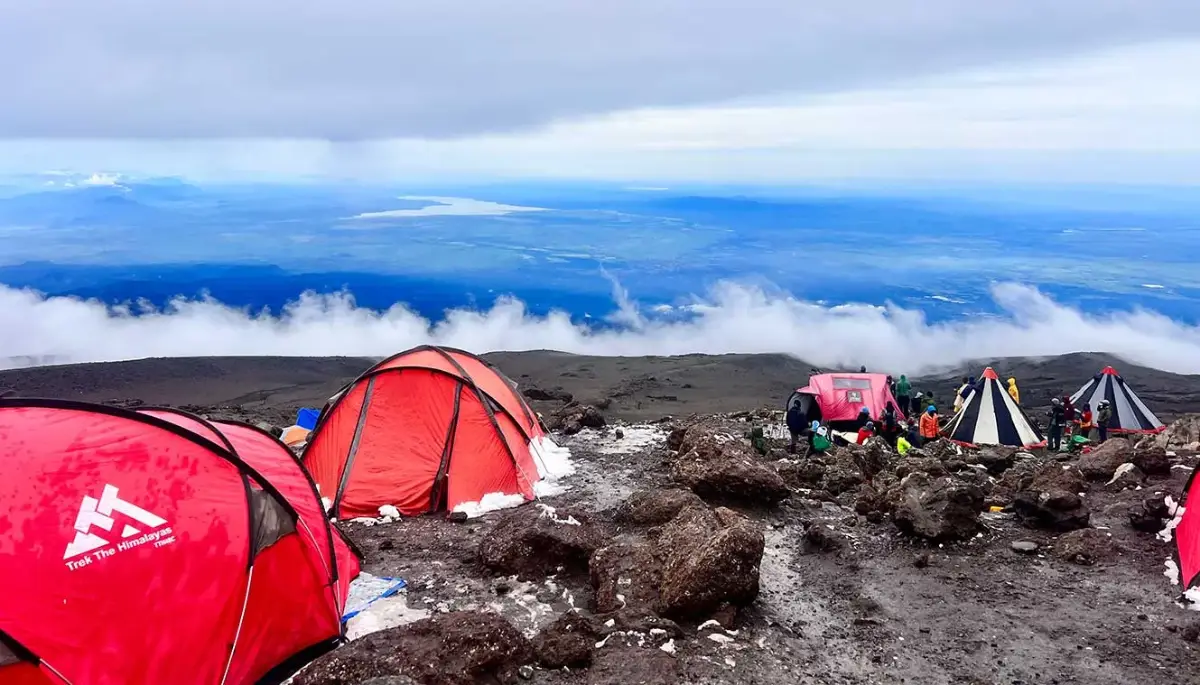
Barafu Camp to Summit to Uhuru Peak and Trek back to Barafu then to Millennium Camp
- Total Trek distance: 16 km.
- Barafu Camp (4,700 m) – Stella Point (5,800 m)
- Trek Distance: 4 km.
- Elevation Gain: 1,100 m.
- A steep, rocky slope with loose scree, climbed at midnight.
The most coveted hike of the Kilimanjaro Trek is the summit climb that begins from Barafu Camp at around midnight. From a height of 4,700 m at Barafu Camp, you will be headed to Stella Point, which is situated at an altitude of 5,800 m. It will be interesting to observe that the glacial deposits have drastically reduced over the years due to global warming. The trail takes you through a steep, rocky slope with loose scree, making the hike a bit challenging particularly at midnight. The distance of this stretch is around 4 km and it will take 4 to 5 hours before arriving at the crater rim of Stella Point.
- Stella Point (5,800 m) – Uhuru Peak (5,900 m)
- Trek Distance: 1 km.
- Elevation Gain: 100 m.
- Witness the breathtaking sunrise from the roof of Africa.
After taking a rest and relaxing for some time at Stella Point, you will continue your hike to your ultimate destination of this expedition – Uhuru Peak, the pinnacle of Kilimanjaro. On this segment of the trek, you will witness the spectacular sunrise and stunning sceneries in the first light of the day. When the sunrays hit the mountain peaks, a gleaming effect is dispersed all around you. With a meager distance of 1 km and one more hour of walking, you will finally reach Uhuru Peak, which is located at a height of 5900 meters. Finally, this is your time to enjoy these magical moments at the Roof of Africa.
- Uhuru Peak (5,900 m) – Millennium Camp (4,000 m) via Barafu Camp
- Trek Distance: 11 km.
- Elevation Loss: 1,900 m.
- Accommodation: Millennium Camp.
After spending some quality time here at the summit and having allowed yourself to sink into the fact that you’ve finally made it, now it’s time to retrace your steps. You’ll be descending down to Millennium Camp, which is 4000 meters, with an elevation loss of 1900 m. You will make your way back through the same route, that is, via Barafu Camp. You will reach Barafu Camp that is 5 Km and then from Barafu Camp to Millennium Camp that is 6 km. Finally, after a rigorous downward journey of 11 km, you will reach your accommodation, Millennium Camp for a well-deserved rest. The joy of climbing to the top of the mountain lingers in your heart as you descend back.
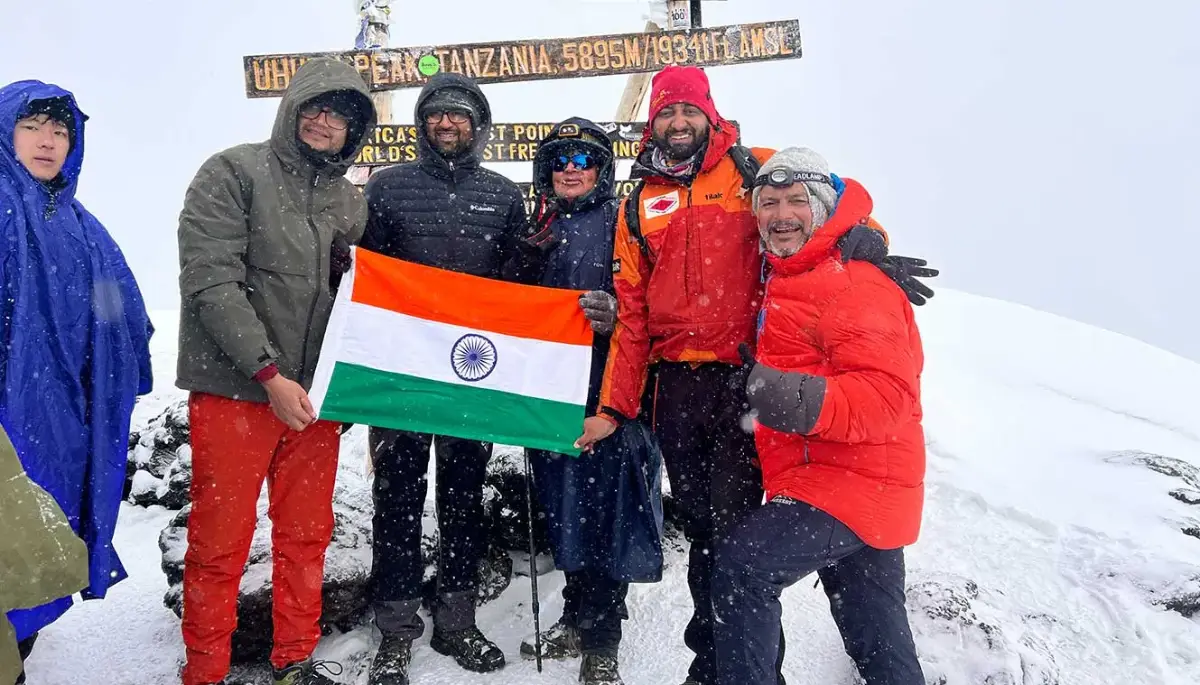
Millenium Camp To Mweka Gate (1700 m) and Drive to Moshi
- Trek Distance: 13 km.
- Trek Time: 5 hrs.
- Drive Distance: 25 km.
- Drive Time: 1 hr.
- Descend through the rainforest to Mweka Gate and receive your well-earned certificates.
- Drive back to Moshi for celebration and relaxation.
On the 8th day of your trip, you will descend to Mweka Gate from Millennium Camp, which is a challenging downhill trek, with an elevation reduction of 1700 m. This is the last leg of your journey by foot, and the trail will take you through a rainforest. This path is normally slippery and it requires you to carry trekking poles. This beautiful eco-zone is thriving with some exotic flora and fauna. On a lucky day, a trekker can witness rare wildlife such as Blue Monkeys, sunbirds, hornbills, and turacos. Your transport will be waiting at Mweka Gate to return you back to Planet Lodge in Moshi, where you can choose to relax – or celebrate!
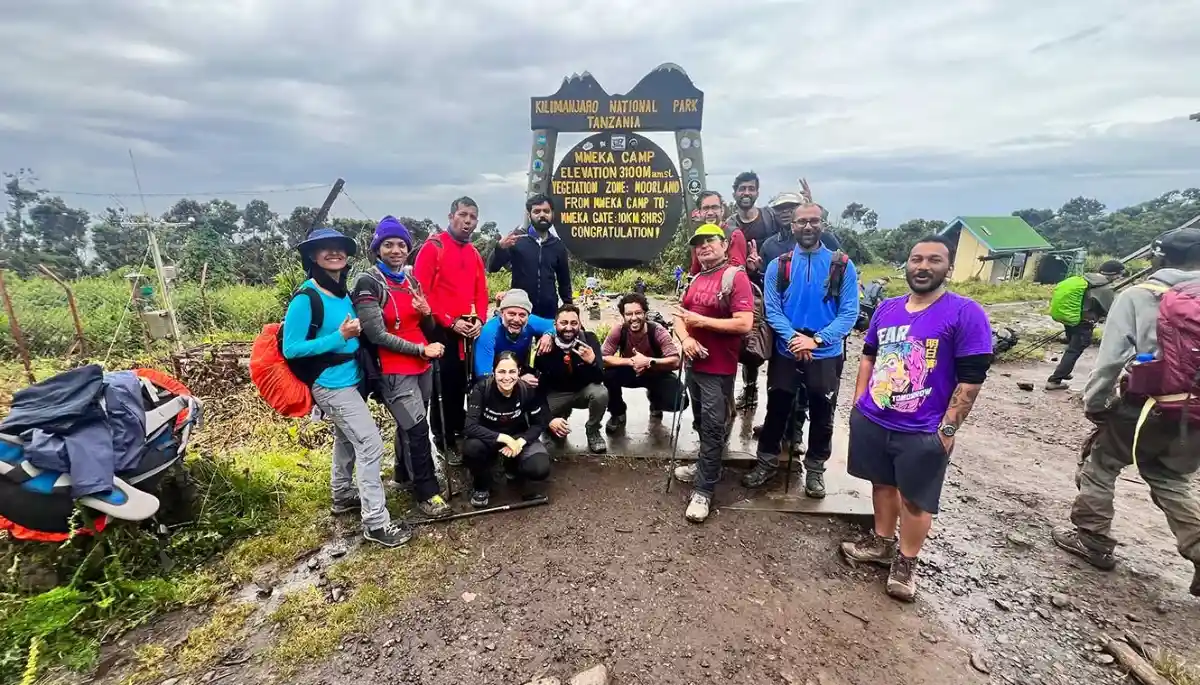
Departure Day
- Transfer from Moshi to Kilimanjaro International Airport.
- Depart with incredible memories and a sense of accomplishment.
After a good night’s rest at your lodge, you will have breakfast ready for the scheduled check-out by 10.00. Please note, if you wish to remain in the hotel during the day, please inform us regarding this at the time when you book the trip. We will inform you about the cost of the day room that ends at 06:00 hrs; after that we will make the booking on your behalf. If you have booked a transfer to the airport, our representative will pick you from your hotel and drop you at the airport. Also, for those travelers who have booked to go on safari, our guide will meet you in the evening and provide you with an important briefing.
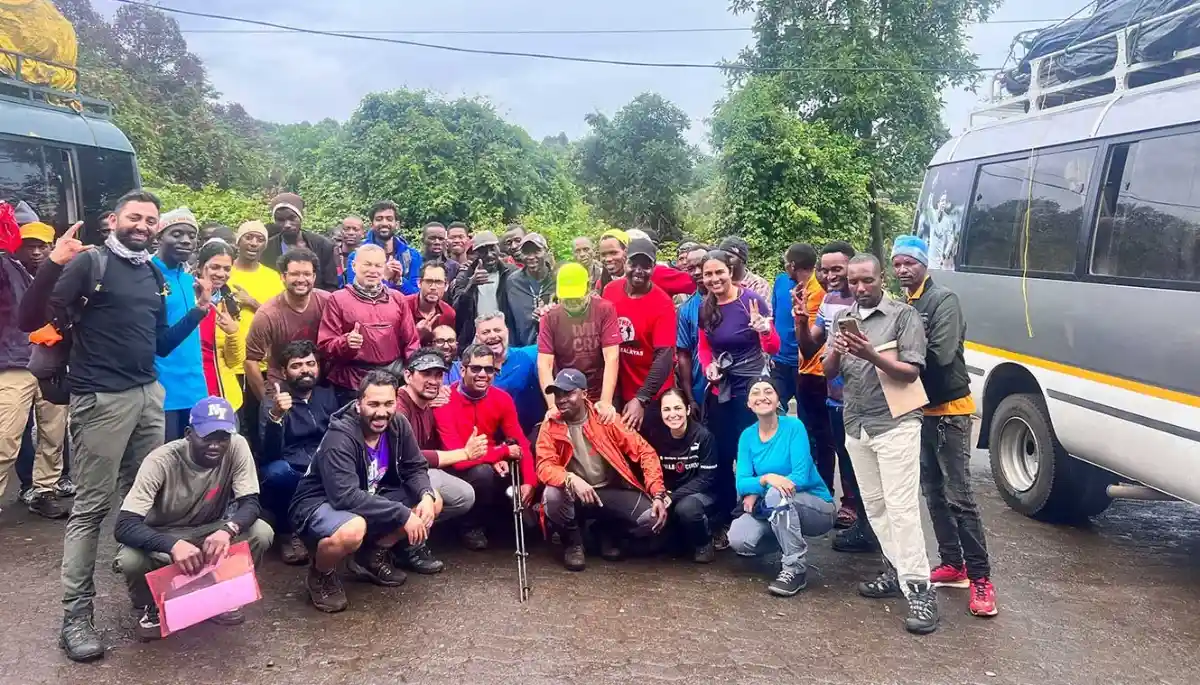
Day-1: Kilimanjaro International Airport To Moshi
- Arrive at Kilimanjaro Airport.
- Stay at a Resort in Moshi.
- Altitude (Moshi): 800 m.
- Airport to Moshi 42 km | 1 hours.
- Pre-climb briefing and equipment check in the evening.
- Explore the city or relax today.
Day-2: Drive to Machame Gate and trek to Machame camp
- Drive distance(Moshi to Machame gate): 31km.
- Drive time: 1 hr.
- Altitude (Machame gate):1,800 m,(Machame Camp): 3000 m.
- Trek Distance: 11 km.
- Hiking Time: 5 - 6 hrs.
- Elevation Gain: 1,200 m
- Habitat: Montane Forest.
- Accommodation: Machame camp.
Day-3: Machame Camp to Shira Camp
- Altitude(Machame Camp): 3000 m, (Shira Camp): 3,800 m.
- Trek Distance: 5-6 km.
- Trek Time: 4-5 hrs.
- Elevation Gain: 800 m
- Habitat: Moorland.
- Full Board Shira Cave Camp.
Day-4: Shira Camp To Barranco Camp Via Lava Tower Camp
- Shira Cave Camp (3,800 m) to Barranco Camp (3,900 m) via Lower Tower Camp (4,600 m).
- Trek Distance: 10 km.
- Trek Time: 5-6 hrs.
- Elevation Gain: 100 m
- Habitat: Moorland.
- Accommodation: Barranco Camp.
Day-5: Barranco Camp To Karanga Camp
- Barranco Camp (3,900 m) to Karanga Camp (4,000 m).
- Trek Distance: 6 km.
- Trek Time: 5-4 hrs.
- Elevation Gain: 100 m
- Habitat: Moorland.
- Accommodation: Karanga Camp.
Day-6: Karanga Camp To Barafu Camp
- Karanga Camp (4,000 m) to Barafu Camp (4,700 m).
- Trek Distance: 4 km.
- Trek Time: 3-4 hrs.
- Elevation Gain: 700 m
- Habitat: Alpine Desert.
- Accommodation: Barafu Hut Camp.
Day-7: Barafu Camp to Summit to Uhuru Peak and Trek back to Barafu then to Millennium Camp
- Total Trek distance: 16 km.
- Barafu Camp (4,700 m) - Stella Point (5,800 m)
Trek Distance: 4 km
Elevation Gain: 1,100 m
A steep, rocky slope with loose scree, climbed at midnight. - Stella Point (5,800 m) - Uhuru Peak (5,900 m)
Trek Distance: 1 km
Elevation Gain: 100 m
Witness the breathtaking sunrise from the roof of Africa. - Uhuru Peak (5,900 m) - Millennium Camp (4,000 m) via Barafu Camp
Trek Distance: 11 km
Elevation Loss: 1900m - Accommodation: Millennium Camp.
Day-8: Millenium Camp To Mweka Gate (1700 m) and Drive to Moshi
- Trek Distance: 13 km.
- Trek Time 5hrs.
- Drive Distance 25km.
- Drive Time 1 hrs.
- Descend through the rainforest to Mweka Gate Receive your well-earned certificates.
- Drive back to Moshi for celebration and relaxation.
Day-9: Departure Day
- Transfer from Moshi to Kilimanjaro International Airport.
- Depart with incredible memories and a sense of accomplishment.
Mount Kilimanjaro Trek Graph
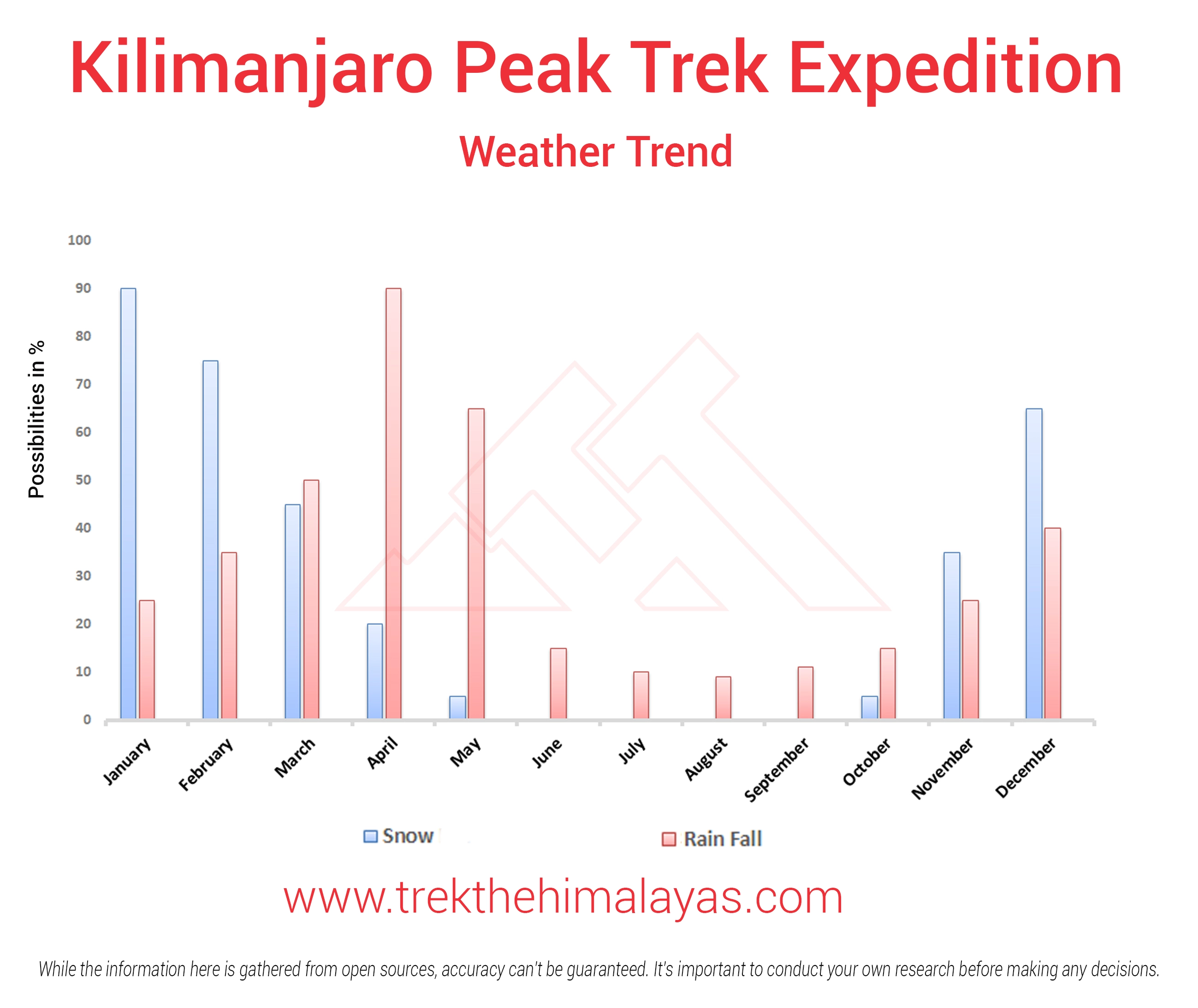


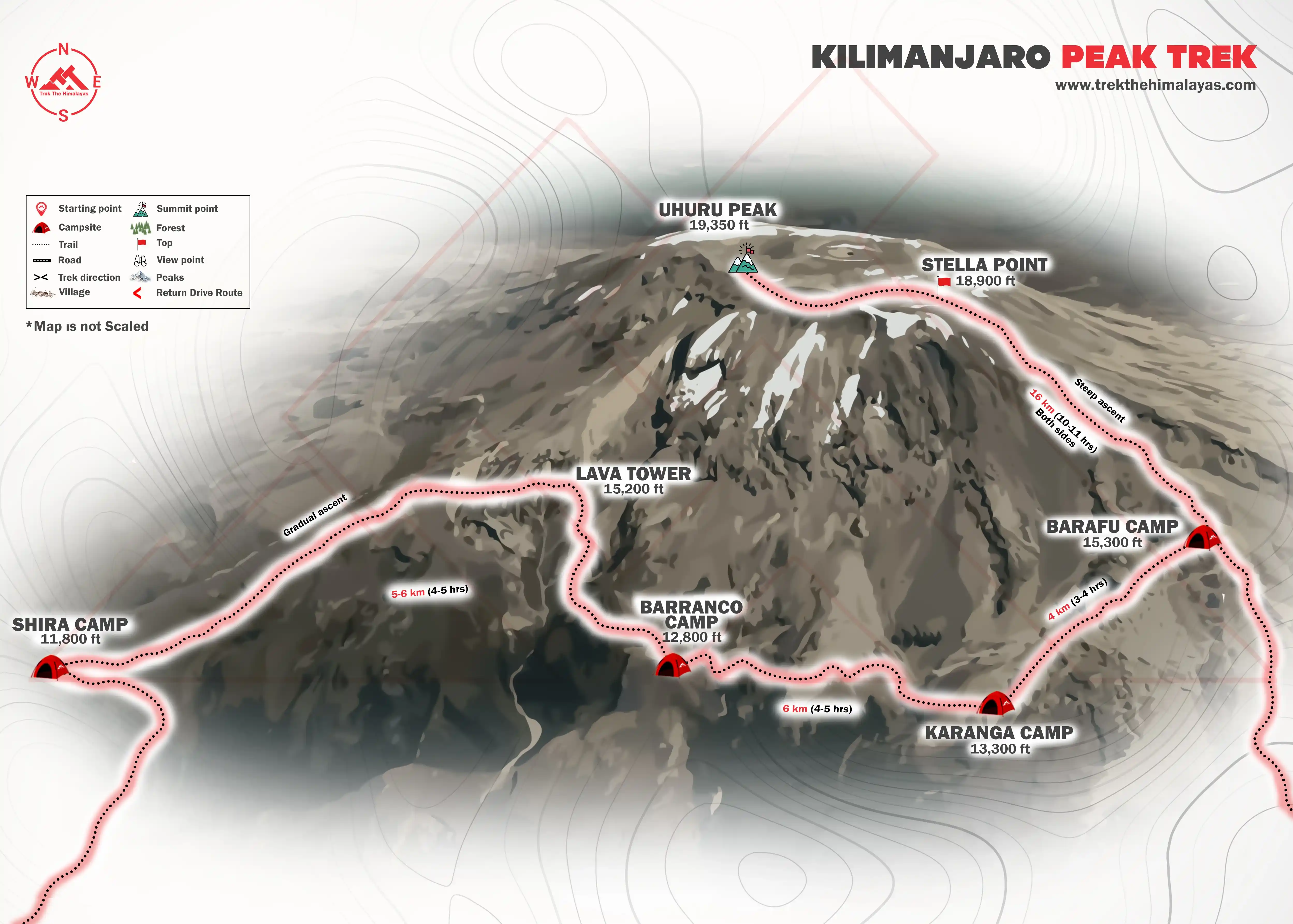

- Pulse rate at rest must be in between (60 to 100 beats per minute).
- Blood Pressure Reading must be in between (DIASTOLIC 75 – 85, SYSTOLIC 100 - 130 mm Hg).
- Respiratory rate at rest must be in between (12 to 20 breaths per minute).
- Should not have Liver and kidney issues.
- Should not have Diabetes Mellitus, Bronchial Asthma, Heart problems, Hypertension, etc.
- No pacemaker implant.
- People with Sinus issues, Epilepsy please contact to trek coordinator before booking the trek.
- If your BMI is not normal, Please contact our Trek coordinator before Trek booking.
Medical & Disclaimer Form (Mandatory Documents) Click here to download Medical & Disclaimer Form
- Junior trekkers (below 15 years) should have a company of parents/guardians.
- Trekkers between 15 to 18 years can come solo with the disclaimer form signed by parent/guardian.
- Medical & Disclaimer Form (Mandatory Documents) Click here to download Medical & Disclaimer Form
Mount Kilimanjaro is the highest free-standing mountain in the world and also the highest mountain peak in Africa. Located on a volcanic massif, Kilimanjaro is a coveted mountain expedition on every trekker’s bucket list. This iconic mountain peak attracts trekkers from all across the globe. The climb to Kilimanjaro is not just about conquering the summit but also experiencing the varied terrain and the culture of the region. Did you know? There are 7 distinct routes that you can choose to climb the mountain and each route has its unique charms and challenges. From the well-explored Machme Route to the less-trodden Northern Circuit, we discuss all the routes in detail in this article so that you can choose a path that resonates with your aspirations and abilities.w
The Different Routes to Climb Kilimanjaro
Machame Route or the ‘Whiskey’ Route
Difficulty: Medium
Distance: 62 km
Duration: 9 days
Success rate: High
Accommodation option: Camping
It is one of the most widely chosen routes to the Kilimanjaro summit along with Lemosho Route and offers stunning sceneries as you climb through five different climatic zones along the trek. This route allows for the walk-high and sleep-low concept, which is excellent for acclimatization. So, even if you are new to the world of trekking, you can choose this path. The route is so popular that as many as 20,000 people climb via this route every year. The trek starts from the southern face of the mountain at Machame Gate near Arusha and you will descend via a different path to Moshi. This route has the highest summit success rate along with beautiful sceneries.
Lemosho Route
Difficulty: Medium
Distance: 70 km
Duration: 7-8 days
Success rate: High
Accommodation option: Camping
The Lemosho Route also has a high success rate when reaching the summit of Kilimanjaro. Similar to the Machame Route, in this route also you will walk high and sleep low, allowing proper acclimatization. Along this route, you will get views of many deep gorges and the western side of Kilimanjaro. If you are lucky, you may spot large wildlife creatures like Antelopes in this region. Usually, people climb this route in 7 days but you can add one day if you want to take a longer time to acclimatize.
Marangu Route or the ‘Coca Cola’ Route
Difficulty: Low
Distance: 72 km
Duration: 5-6 days
Success rate: Low
Accommodation option: Huts
This is the shortest route to climb Kilimanjaro but it also offers less time for acclimatization. The trek takes place along the eastern slope of Kilimanjaro. Also, known as the Coca-Cola Route, this route used to be the most popular trail to climb Kilimanjaro before the newer Machame Route and Lemosho Route were opened. The trek follows the same route for the ascent as well as descent and is often chosen by people who want to climb Kilimanjaro on a budget, owing to the dormitory-style hut accommodations with basic amenities. It takes only 5 to 6 days to complete the trek via this route. This route is also chosen by many as one doesn’t have to climb the Barranco Wall. However, the mediocre acclimatization profile leads to a lower summit success rate compared to other routes.
Shira Route
Difficulty: Medium
Distance: 56 km
Duration: 7-8 days
Success rate: High
Accommodation option: Camping
The Shira route starts on the western slope of the mountain and it is the route with the highest starting elevation at around 3500m. The beginning of the trek at such a high altitude means there is a higher chance of developing altitude sickness. So, if you are planning to do the trek via the Shira Route, we recommend doing a smaller acclimatization trek like Mt. Meru Trek before climbing Kilimanjaro. The trail is quite similar to the Lemosho route in terms of scenery but you miss out on the beautiful rainforest section of Machame and Lemosho.
Rongai Route
Difficulty: Low
Distance: 73 km
Duration: 6-7 days
Success rate: Medium
Accommodation option: Camping
This is the only route with a northern approach to climb the mountain. This route is more like one long trek with a gradual ascent which significantly reduces the difficulty level. Along the trek, you will get lovely views of the northern side of the mountain and even see Kenya’s Amboseli National Park in the distance. The rainforest and moorland sections are also quite pretty with a beautiful opportunity to see the sunrise over Mweka Peak. This route, however, doesn’t offer walk-high, and sleep-low opportunities and thus there’s a lesser chance for natural acclimatization. You can also add an extra day for proper acclimatization.
Northern Circuit Route
Difficulty: High
Distance: 98 km
Duration: 9-10 days
Success rate: High
Accommodation option: Camping
The newest route to climbing Kilimanjaro, the Northern Circuit is also the longest route to the summit. The trek starts on the western side but then wraps around the northern slope of the mountains leading to the summit. The long itinerary increases the difficulty of the trek, however, this route also has a high summit success rate as the longer duration gives a greater chance for natural acclimatization. Many do not choose This route due to the lengthy climb to the summit. The Northern Circuit starts from the same point as the Lemosho Route and then traverses along the northern side to the Uhuru Peak. If you have time on your hand and do not have a limited budget then you can opt for this route.
Umbwe Route
Difficulty: High
Distance: 53 km
Duration: 5-6 days
Success rate: Low
Accommodation option: Camping
This is also a short route to climb Kilimanjaro but it is extremely steep and as such the summit success rate is quite low. The trail goes along the southern slope of the mountain and the rapid ascent gives a lesser chance for acclimatization. Also, the route takes place along a very remote region during the first two days. This is the least chosen route owing to the poor acclimatization profile and the summit success rate is also pretty low. If you are going to trek via this route, we strongly suggest pre-acclimatization.
How to Choose the Right Route?
Choosing the route to climb the mountain depends on multiple factors and the kind of experience you wish to have. Here are some tips to help you choose the route that’s right for you.
1.Identify your requirements
Once you figure out what you want to experience from the trek then it becomes easy for you to select a route. Are you looking for a getaway completely away from the crowd? Is reaching the summit your top priority? Are you looking for excellent photographic opportunities? Identify what you want and then choose a route that will best serve your requirements.
2.The sceneries along the trail
When it comes to natural sceneries, some routes are better than others. If it is stunning landscapes you wish to see then we suggest the Machame, Lemosho, Shira and Northern Circuit Route.
3.Acclimatization option
Different routes offer different levels of acclimatization and it should definitely be a big consideration when you are selecting the route. A route that does not have rapid ascend is good for acclimatization and also some routes offer walk-high and sleep-low opportunities making them a better fit for acclimatization. Machame Route, Lemosho Route and the Northern Circuit Route are the best for acclimatization.
4.Consider your budget
If you are on a budget then you should consider choosing the more cost-effective routes. As a rule, the shorter the trek, the cheaper they are, however, you should also remember that this might affect your chances of the summit if you haven’t properly acclimatized prior to the trek.
5.Consider the accommodations
All routes to climb Kilimanjaro offer camping accommodation except the Marangu Route which has hut accommodation. So, when choosing the tour operator make sure they offer good quality tents to make your experience more comfortable.
6.The presence of the crowd
If you are someone who wishes to divert away from the crowd and climb the mountain along the offbeat path then consider a route that is not usually chosen by the climbers. On the other hand, if you wish to meet like-minded people on the trail then you can choose among the popular routes of Kilimanjaro.
7.The time you want to spend
Different routes take different amounts of time to complete the climb. Some routes take fewer days while some are longer. So depending on the number of days you can invest, you can choose the route based on that. However, remember that climbing the mountain is not some kind of race and you should choose a route that you will be most comfortable to climb.
8.Prior trekking experience
The route you choose greatly depends on whether you have prior trekking experience or not. While fitness is a must-have criterion for any route, some trails are tougher than others and not suitable for beginners. The Umbwe Route for instance is quite steep and follows a rapid ascent, so prior trekking experience is a must when climbing via this route.
Mt. Kilimanjaro as we all know it today, lies in the East African nation of Tanzania. The mountain sits right on the border of Kenya and Tanzania and can be seen on both sides. Over the years, there have been debates about which nation the mountain peak belongs to and finally, the peak ended up in the land of Tanzania. In this article, we will delve into how it was settled that Kilimanjaro is a part of Tanzania and some accounts and evidence that prove the same. The mountain has a very interesting backstory and we would like to share it with you.
A common confusion – Is Kilimanjaro in Tanzania or Kenya?
If you look at the map of Kenya, you will notice that from Lake Victoria to the coast, it is a straight line with just a small curve and this bend is actually around Mount Kilimanjaro, which conveniently places the mountain on the Tanzanian land.
Kilimanjaro was never a part of Kenya but there is a popular story that runs around which adds to this confusion The legitimacy of this story has never been determined, however, it is a very popular account in that region. It is said that Queen Victoria gifted the mountain to Kaiser Wilhelm II of Prussia, as a birthday present. While this story makes for a great account, it is unsubstantiated. This story was often used as a marketing gimmick that allowed tour operators to hoodwink tourists into believing that Kilimanjaro is in Kenya.
The border demarcation between Tanzania and Kenya was completely arbitrary until it was legitimized in the early 1900s. The arbitrary nature of the borderline created undue confusion and disagreement among the two nations regarding the belonging of the mountain.
Proof of Kilimanjaro belonging to Tanzania
In earlier times, Germany and Britain reached an agreement regarding the location of Mount Kilimanjaro, though they disagreed on where the demarcation line from the mountain to Lake Victoria should end. The British suggested a line from Kilimanjaro to Speke Gulf, while the Germans proposed a line to North Musoma. Another map from the German side illustrates a direct demarcation line from the northeastern corner of Lake Victoria to Mombasa. In both maps, Mount Kilimanjaro is depicted as part of where present-day Tanzania is.
The book ‘Why Kilimanjaro is in Tanzania’ by Schneppen Heinz gives a more plausible reason for the same. The book was published in 1996 and gives more reasoning and proof that Kilimanjaro belongs to Tanzania. The gist of the book is that the Germans had gained Mt. Kilimanjaro while Britain gained Mombasa. If we look at the recent day map, Mombasa is in present-day Kenya so Kilimanjaro belongs to Africa and the present-day nation of Tanzania. The assertions in the book are based on the Heligoland - Zanzibar Treaty of 1st July 1980. According to this treaty, Germany gave up the claim of the Zanzibar Sultanate which stretched as far as what is the present-day Kenyan coast in exchange for the coast of Dar Es Salaam and Heligoland.
Between 1800 and the defeat of Germany in World War I, the East-African region constituted areas which are currently known as Rwanda, Burundi, and mainland Tanzania. The Heligoland-Zanzibar treaty does not mention any mountain, however, the demarcation line around the mountains does not appear to have changed. It is very much possible that by giving away the claim of the Zanzibar Sultanate (Kenyan coast currently), the Germans acquired Mt. Kilimanjaro.
Looking from an East African perspective, it was either the coast of Mombasa or Kilimanjaro. So giving up a coastline for a mountain does seem like a fair deal.
Mt. Kilimanjaro as we all know is the highest peak in Africa and also the largest free-standing mountain in the world. This mountain peak has long been the fancy of climbers and mountaineering enthusiasts. Every year throngs of people climb this mountain and it has become one of the most popular expeditions in the world. Beyond the adventure that Kilimanjaro provides, the mountain has also witnessed some extraordinary feats of human achievement that have been etched in the annals of world records. In this article, we are going to share the most remarkable world records set on Mt. Kilimanjaro. From the fastest ascent to the fun endeavours, these records illuminate the indomitable human spirit and the boundless possibilities that a mountain can offer.
1.The fastest supported ascent to Kilimanjaro
The fastest supported ascent to Mt. Kilimanjaro belongs to Karl Egloff, a Swiss mountain runner. On 13th August, 2013, he made a record-breaking ascent to the top of the summit at 5895 m within 4 hours 56 minutes beating Spanish runner Kilian Jornet’s record of 5 hours 23 minutes. Karl climbed the mountain by the Umbwe route to Uhuru Peak and descended to Mweka Gate, resting only for 4 minutes on the summit before descending down in 1 hour 42 minutes making the total ascent and descent time to be a total of 6 hours 42 minutes.
2.The fastest unsupported ascent
The fastest unsupported ascent to Kilimanjaro was made on 22nd February 2006 by Simon Muty from Tanzania. He made a record by reaching the summit within 9 hours and 21 minutes. He climbed via the Umbwe route and descended to the Mweka Gate. The ascent time was 6 hours and 33 minutes while the descent took him 2 hours and 46 minutes, resting only for 3 minutes at the summit. In an unsupported climb, the climber has to carry all his equipment on his own and doesn’t take the help of any resupply points. This type of challenge is much more difficult than the supported climb.
3.Fastest ascent to Kilimanjaro on crutches
John Stanford Hart from the UK made the fastest ascent to Kilimanjaro in October 2009 on crutches. It took him 4 days 20 hours and 30 minutes to reach Uhuru Peak.
4.The youngest person to climb Kilimanjaro
5 years old Ognjen Živković from Serbia is the youngest person to summit Kilimanjaro as of date. He reached Uhuru Peak via the Machame Route in six days, reaching the summit on 6th August 2023. He broke the world record of Ashleen Mandrick (6 years old), who submitted the mountain in 2019.
5.Oldest person to climb Kilimanjaro
Arizona Lorimar from Arizona holds the record of being the oldest person to climb Mt Kilimanjaro at the age of 89 years on 12 July 2019. Originally, she climbed the mountain in July 2015 at 85 years old making her the oldest woman to summit Kilimanjaro. However, her record was broken in October 2015 by Angela Vorobeva, aged 86 years old, followed by another Dr Fred Distehorst at 87. But this did not deter Lorimar and she ascended the summit once again in 2019, aged 89 this time and again setting a new record.
6.Highest Cricket Match in the World
The world’s highest cricket match was played in Kilimanjaro. A group of 30 cricket players and officials played the highest-ever cricket match in the world in 2014. The match was played in Twenty20 style. Among the players were notable names like Ashley Giles (former England player), Makhaya Nitni (former South African fast bowler), Clare Connor (former captain of England Women’s Cricket Team), and Heather Knight (current player of English Women’s cricket team).
7.Highest Rugby Match in the World
The highest rugby match in the world was played on 18th October 2015 atop Kilimanjaro. A team of 38 rugby players including rugby legends like Mike Wainwright, Lee Briers, Alan Hunte, Adrian Morley, Chico Jackson, and Barrie McDermott joined the team along with BBC’s Beccy Meehan and former reporter for Sky Sports’ Rugby League. The team was then climbing for a charity – the Steve Prescott Charity Foundation (SPF) and pulled off a wonderful rugby match atop the mountain.
8.World’s Highest Female Football Match
An all-female soccer team made a world record for playing the highest football match in the world in June 2017 atop Mt. Kilimanjaro. The team saw 30 professional football players from 20 nations across five continents. The match took place at an altitude of nearly 19,000 ft in the crater of Mt. Kilimanjaro as a part of the Equal Playing Field Project.
9.World’s Highest Pizza Delivery
Amid the many records on Kilimanjaro, this one stands out particularly. This incredible feat was achieved by Pizza Hut in collaboration with Yum! Brands in the USA to mark the launch of the Pizza Hut franchise in Tanzania. The delivery challenge started on 5th May 2016 and the team reached the summit on 8th May 2016, celebrating the 100th Pizza Hut franchise opening with a slice of pizza at the summit. The pizza was made in the Dar Es Salaam restaurant and then flown to Kilimanjaro, where it was transported to the trailhead. It was then carried in an insulated pack heated by batteries, specially designed to keep the pizza fresh and horizontal.
10.Climbing Kilimanjaro Backwards
Nepali Mountaineer, Sanjay Pandit set this unique world record by climbing Kilimanjaro walking backwards and that too within an astonishing duration of 25 hours and 40 minutes. The climb took place between 15 to 18th December 2015. Sanjiv also climbed Mt. Kosciuszko, the highest peak in Australia backwards. It took him 5 hours and 45 minutes.
Incredible feats indeed! These records on Mount Kilimanjaro stand as a testament to the unwavering zeal of the human spirit, showcasing the indomitable drive to surpass limits, both physical and mental.
Kilimanjaro lies in the East African country of Tanzania and is quite close to the Equator. Being this close to the equator, it does not experience the same four seasons as other parts of the world. Kilimanjaro rather experiences two distinct seasons throughout the year – rainy seasons and dry seasons. In this article, we will delve into a comparison between the wet and the dry seasons of climbing Kilimanjaro. You will get detailed information about all the aspects of both seasons so that you can make an informed decision on which season suits your preferences better.
Wet Season in Tanzania
The rainy season in Tanzania is divided into two parts one is the short rainy season from late October to mid-December. During this time you can expect a mix of rain and sun. The weather is typically warm and it is not dusty at all.
The long rainy season starts in late March and lasts till early June. Mostly it is raining during this time however, you will occasionally have a clear day when the sun is out. From May onwards the weather becomes cooler and there isn’t dust at all during this time either.
Advantages of climbing in the rainy season
During the rainy season, the slopes of Kilimanjaro are extremely green and vibrant. If you want to experience nature at its fullest then this is a great time to climb the mountain.
You will see the snow-capped summit of the mountain. There is snow on the summit only during the wet season. March to May is a great time to see snow at the summit of Kilimanjaro.
During the wet season, the crowd is much less as compared to the dry season and there is actually a real chance for you to be alone during the trek. For those seeking a secluded experience, this is a good time for them.
This is the time when the trail is free of dust. The dry months especially the hot ones see quite a bit of dust, so if you wish to avoid that, the rainy season is the right time for you to experience Kilimanjaro
The lush, green landscapes of the rainy season provide photographers with unparalleled opportunities to capture stunning images of Kilimanjaro's natural beauty.
Disadvantages of climbing in the rainy season
Fog and rain are more likely to cloud the view in the wet season than in the dry one.
Expect the trails to be muddy.
Tips for trekking in the rainy season
The northern face of the mountain receives less rainfall than the southern side. So, you may opt for selecting the Rongai or Marangu Route. However, if you wish to witness the lush greenery and beauty of Kilimanjaro in monsoon then Machame Route is the best option.
Opt for shoulder season, either in the front or tail end of the monsoon so that you get to experience pleasant weather.
Make sure to get quality gear. Have waterproof and breathable jackets, pants and boots. Also, ensure that your backpack has a rain cover.
Pack everything inside your duffle bag or backpack in ziplock or plastic bags.
Check the weather forecast before venturing out on the trail.
In the rainy season, temperature can fluctuate so bring extra layers.
Despite the cooler temperatures and rain, it's essential to stay hydrated. Drink plenty of water throughout the day to maintain hydration levels and prevent altitude-related illnesses.
Dry Season in Tanzania
Like the rainy season, there are also two dry seasons throughout the year. Late December to mid-March is a dry season. The weather is warm and it begins to get dusty towards the end of the season.
From mid-June to October is another dry season in Tanzania. The weather is cooler during this time, especially in the mornings and evenings.
Advantages of climbing in the dry season
During the long dry season, the temperature is cool and during the short dry season, the temperature is warmer. Either way, the skies are mostly clear during these times of the year.
January and February are the peak season to climb Kilimanjaro as the weather begins to transition from the short dry season to the long rainy season, making it a pleasant time to do the expedition.
There is minimal precipitation during this time, so the trails are not muddy and you can also trek comfortably if you yourself are dry. For someone, who does not want precipitation on the trek, it is the right time to do the trek.
The dry season is associated with higher summit success rates on Mount Kilimanjaro. The clear skies and favourable weather conditions increase your chances of reaching the summit.
With clear skies and minimal cloud cover, you'll have uninterrupted views of the snow-capped peaks and the diverse mountain ecosystems.
Disadvantages of climbing in the dry season
While the dry season typically boasts clear skies and minimal precipitation, it also brings colder temperatures, especially at higher altitudes.
Clear skies during the dry season mean more direct sunlight, which can result in higher UV exposure and an increased risk of sunburn and heat-related illnesses.
The Machame and Marangu routes experience a lot of crowds.
Tips for trekking in the dry season
In the dry season, you have clear skies and brighter days, which also means intense sunlight and UV exposure, especially at higher altitudes. Protect your skin by wearing sunscreen with a high SPF rating as well as sunglasses and hats.
Dress in layers, so that you can adjust your clothes along with the temperature changes.
Pack essential gear and equipment as well as rain cover. Kilimanjaro is known for receiving unexpected rainfall even in the driest months so be prepared for it.
Note: All this being said, Kilimanjaro sometimes creates its own unique weather. This means that even though the weather is pretty predictable, you may experience slight drizzles on the trek. If you wish to experience a completely dry trek and avoid rainfall, this cannot be guaranteed 100 per cent as even in the driest seasons, you may experience unexpected rainfall on the slopes of the mountain.
PASSPORT & VISA REQUIREMENTS
- All nationals visiting Tanzania must carry their passport when entering the Republic of Tanzania.
- The passport should be valid for at least 6 months past the date of entry into the country.
- Your passport should have at least one blank page for official stamps.
Visitor’s Visa
Most foreign countries require a visa to visit Tanzania except for some commonwealth countries. You can obtain your Visa either before arrival or on arrival at your port of entry. All non-commonwealth countries require a Visa unless your country has a pact with the Tanzanian Republic and the Visa requirement has been waived for your nation.
Commonwealth countries do not require a Visa to visit Tanzania. However, India Australia, the UK, New Zealand, Canada, USA, and most EU countries require a Visa.
How to apply for your Visa?
- To arrange your Visa in advance, you can simply contact the Tanzanian Embassy in your country. Usually, they ask for your passport and you fill out an application form that is processed by the Embassy and you are issued your Visa.
- You can also apply for your Visa online Visa online. The process is simple, you fill out an online form, make the payment and submit your application form. Your application will be reviewed and processed and you will be notified via email whether your application has been accepted or rejected. You may even need to visit the Embassy Office for an interview.
Note: Before you apply online for your Visa. Keep the following points in mind.
→ The type of Visa you are applying for.
→ The documents required for the application.
→ Countries that do not require visas.
→ Nationals that require approval by the Tanzania Commissioner General of Immigration for entry.
Visa on arrival
To avoid delays in obtaining the Visa, many people opt for the Visa on arrival option. You can simply purchase your Visa upon entering Tanzania. While this option is practically trouble-free, if it’s a peak visiting season then the queues can be pretty long.
Entry points from where you can purchase a Visa on arrival
- Kilimanjaro International Airport
- Dar Es Salaam International Airport
- Zanzibar International Airport
- Namanga Entry Point (Tanzania-Kenya border point)
- Horohoro
- Tunduma
- Sirari
- Kigoma port
Countries that do not require a Visa to visit Tanzania
66 countries of the world do not require visas to enter the Republic of Tanzania. The following are this list of the countries:
Botswana, Cocoas Island, Ghana, Heard Island, Rwanda, Seychelles, Vanuatu, Bermuda, Channel Island, Jamaica, Malaysia, Papua New Guinea, Turks and Caicos, British Indian Ocean Territory, Mozambique, Samoa, Tonga, Zambia and Zimbabwe, Belize, Cook Island, Isle of Man, Montserrat, Singapore, Ashmore & Certie Island, Grenada, Lesotho, Naue Island, Swaziland, Brunei, Gambia, Jersey, Malta, Ross Dependency, British Virgin Island, Saint Kitts and Nevis, Cyprus, Hong Kong, Nauru, South African Republic, Malawi, Saint Lucia, Cayman Island, Mauritius, Anguilla, Guyana, Romania, Antigua & Barbuda, Saint Vincent, Guernsey, Solomon Island, Madagascar, Gibraltar, Bahamas, Macao, Uganda, Kiribati, Falkland Island, Christmas Island, Dominica, Saint Helena, Trinidad and Tobago, Kenya, Tuvalu, Namibia, Barbados.
OTHER ENTRY REQUIREMENTS IN TANZANIA
Yellow fever vaccination
If you are arriving from a country that has the risk of Yellow Fever, even if it was a layover, you will need to show proof of Yellow Fever Vaccination.
→ Travelling through any of the following countries, will you need a vaccination card:
AFRICA – Angola, Benin, Burkina Faso, Burundi, Cameroon, Central African Republic, Chad, Republic of the Congo, Democratic Republic of the Congo, Côte d’Ivoire, Equatorial Guinea, Ethiopia, Gabon, Gambia, Ghana, Guinea, Guinea-Bissau, Kenya, Liberia, Mali, Mauritania, Niger, Nigeria, Rwanda, Senegal, Sierra Leone, South Sudan, Sudan, Togo, Uganda.
AMERICANS – Argentina, Bolivia, Brazil, Colombia, Ecuador, French Guiana, Guyana, Panama, Paraguay, Peru, Suriname, Trinidad and Tobago, Venezuela.
→ Tanzania is considered a low-risk area for Yellow Fever. If you are coming to Tanzania without a vaccination card, make sure you take precautions against mosquito bites.
→ Travellers travelling from Tanzania to South Africa are required to have a Yellow Fever vaccination certificate upon entry to South Africa.
→ Please recheck regulations before travelling, as the above is subject to change without notice.
Proof of sufficient funds
You will need to have sufficient funds to help you sustain during your stay in Tanzania and you might even have to show the proof if asked.
Proof of return or onward journey
You will likely be asked to show your return or onward ticket out of Tanzania.
RECOMMENDED IMMUNISATIONS
As a sensible precaution we recommend that you consider getting at least some of the following recommended immunizations:
- Hepatitis A – You can get Hepatitis A through contaminated food or water in Tanzania, regardless of where you are eating or staying.
- Typhoid – You can get Typhoid through contaminated food or water in Tanzania, especially if you are visiting smaller cities or rural areas.
- Please check with your local travel clinic for the latest recommendations
IMPORTANT THINGS TO KEEP IN MIND
- Credit cards / Travellers Checks
Credit cards are only accepted by the major airline companies and by most of the bigger hotels and lodges. Do not rely on credit cards as a source of cash while in in Tanzania. In some cases, a surcharge will be added to credit card payments. We suggest that you take sufficient cash and use the credit card as a backup only. Traveller’s checks are accepted at most banks and some hotels, however, a surcharge normally applies to exchange traveller’s checks into cash. Please note many shops/hotels don’t accept traveller’s checks.
- Currency
The Tanzanian Shilling is the local currency, but traveller's checks and cash in US$ are recommended. It is possible to change foreign currency at any Bureau de Change, which generally gives better rates than hotels and most banks. If you bring US $ cash or receive the US $, please make sure the bank notes are in good condition with no cuts or damage and that the bank notes are not older than 2008.
- Duty-free
→ The following items may be imported into Tanzania, by travellers older than 18 years, duty-free:
→ 250g of tobacco or 50 cigars or 200 cigarettes
→ One bottle of alcoholic beverage
→ 580 ml of perfume
→ Prohibited Imports
→ Unlicensed firearms and ammunition. Plants and plant products require a phytosanitary certificate.
- Prohibited Exports
→ The export of gold, diamonds, and tanzanite, unless bought from a licensed jeweller is prohibited.
→ Exporting souvenirs made from wildlife skins (this includes reptiles), shells, and coral is forbidden.
- Electricity
→ The local electricity supply is 230 volts, 50 Hz. You will need to supply your own international standard adapter for your electrical appliances.
→ Most hotels in Tanzania use plugs with 3 large flat prongs (“British” type – BS1363 system), however, some hotels also use plugs similar to the “French” type (2 parallel prongs) but with an earth connector.
- Insurance
It is strongly advised to take out travel insurance which should cover baggage as well as personal accident and medical insurance and specifically covering your Kilimanjaro expedition.
Important Links
- Mandatory Documents to Bring on A Trek Click Here.
- How to pay Add-ons, Submit Medical Forms, and Dietary Preferences Click Here to watch Video
How To Reach
The designated pick-up and drop-off location is Kilimanjaro International Airport, and this is already included in the overall cost.
How to Reach Tanzania? A Complete Travel Guide
Where to Fly?
There are three international airports in Tanzania:
-
The Kilimanjaro International Airport in Kilimanjaro.
-
Julius Nyerere International Airport in Dar Es Salaam.
-
Abeid Amani Karume International Airport in Zanzibar
Other airports that connect to Tanzania:
-
Addis Ababa Bole International Airport, Ethiopia
-
Jomo Kenyatta International Airport, Kenya
The Best Way to Reach Kilimanjaro
The best and cheapest way to travel to Tanzania is to fly and then take a shuttle. First, fly to Nairobi or Ethiopia and then shuttle your way to Kilimanjaro.
Kilimanjaro Airport to Arusha
Arusha and Moshi are the two nearest cities to the Kilimanjaro Airport. There are taxis available at the Kilimanjaro Airport that will take you to Arusha. You can also pre-book your taxis for a smoother experience. It takes approximately 1 hour in light traffic to reach Arusha.
Dar Es Salaam Airport to Arusha
The Dar Es Salaam Airport is another entry point to Tanzania and people climbing Kilimanjaro often arrive via this airport. Dar Es Salaam also offers light domestic aircraft connecting to Arusha.
There are six ways you can travel to Arusha from Dar Es Salam Airport.
→ Fly from Dar Es Salaam to Arusha.
→ Fly from Dar Es Salaam to Kilimanjaro and then take a taxi to Arusha.
→ Take a shuttle to Arusha. It will take around 18 hrs.
→ Take a ferry to Zanzibar and fly to Arusha. It takes about 4 hrs.
→ Take a bus from Dar Es Salaam to Arusha. It takes around 10 hours.
→ Take a cab from Dar Es Salaam to Arusha. It takes around 9 hrs.
Zanzibar Airport to Arusha
Some people also prefer to fly to Zanzibar International Airport and then reach Arusha or Moshi to climb Kilimanjaro.
There are 4 ways to travel from Zanzibar International Airport to Arusha.
→ Fly to Arusha. It takes around 1 hour.
→ Take a ferry from Zanzibar to Dar Es Salaam and then take a train to Arusha. It takes around 3 hrs.
→ Fly to Kilimanjaro and then take a taxi to Arusha. It takes around 3 hrs
→ Take a ferry from Zanzibar to Dar Es Salaam and then take a bus to Arusha. It takes about 12.5 hrs.
In case you are flying to Kenya and want to reach Arusha
-
In case you are flying to Kenya, the cheapest way to travel from Nairobi Airport to Arusha is to take a shuttle. It takes about 5 hrs.
-
The fastest way to travel to Arusha from Nairobi is to fly which takes 2 hrs.
-
There are also direct bus services between Nairobi and Arusha run by Kidia One Express that depart once daily and arrive at Arusha Station. The journey takes about 4.5 hrs.
In case you are flying to Ethiopia and want to reach Arusha
-
The cheapest way to travel from the Addis Ababa Airport in Ethiopia to Arusha is to take a taxi. The journey, however, is a long one and can take up to 28 hrs.
-
The fastest way is to fly from Addis Ababa to Arusha and it takes about 3.5 hrs.
- Best way is to fly from Addis Ababa to Kilimanjaro International Airport and take taxi to Arusha.
-
Ethiopian Airlines, Kenya Airways, and Precision Air offer flights from Addis Ababa to Kilimanjaro Airport.
Reaching Tanzania from India
There are no direct flights from India to Tanzania. However, some flights connect major Indian cities like Delhi, Kolkata, Mumbai and Bangalore via Dubai, Abu Dhabi, Doha, Addis Ababa and Nairobi.
Reaching Tanzania from the UK
If you are travelling from the UK, the best and cheapest way to reach Tanzania is to fly to Nairobi first and then
take a shuttle to Tanzania.
Some airlines also provide direct flights to Kilimanjaro International
Airport.
Reaching Tanzania from Canada
From Canada, you can find many direct flights to Kilimanjaro International Airport. It is the fastest way to reach
Tanzania.
Alternatively, you can fly to Nairobi in Kenya and then take a shuttle to Tanzania.
Reaching Tanzania from the US
From the USA, you can find many direct flights to Kilimanjaro International Airport.
It is the fastest way to reach Tanzania.
Alternatively, you can fly to Nairobi in Kenya and then
take a shuttle to Tanzania.
The designated pick-up and drop-off location is Kilimanjaro International Airport, and this is already included in the overall cost. Our objective is to optimize transportation arrangements to enhance your convenience. We achieve this by categorizing drop-off services based on the duration of your flights. Travelers with flights scheduled between 1 and 2 hours will be grouped together, ensuring they receive customized and convenient transportation services to the airport.
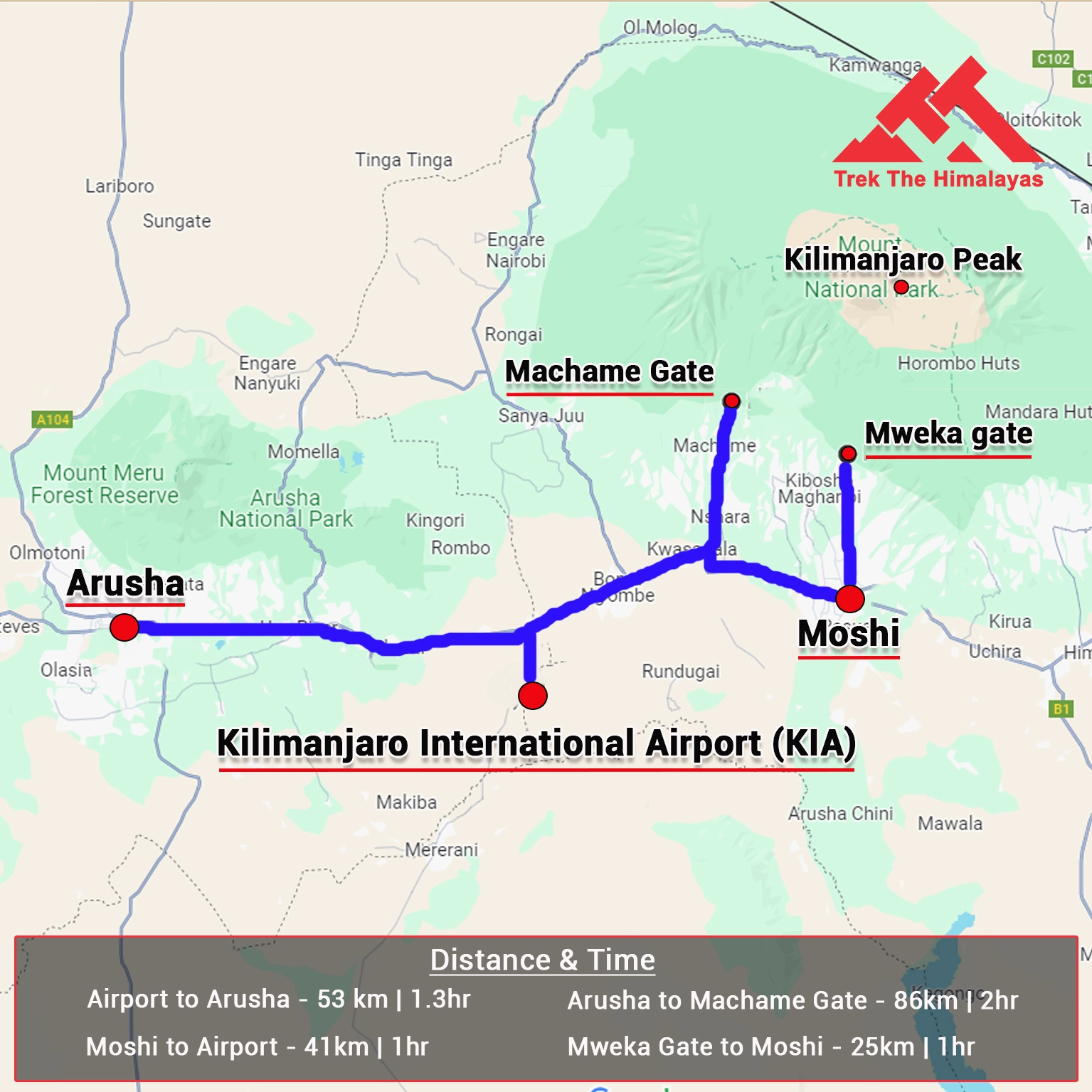
Cost Terms
Inclusion
1. Accommodation (as per the itinerary):
- Day1 night stay in Hotel at Moshi.
- Day 8 night stay in Hotel at Moshi
- Camping while the trek (Twin sharing basis).
2. Meals (Veg + Egg):
- From Lunch on Day 2 to Lunch on Day 8 while on Trek.
- Food of superior quality and variety offered for the duration of your climb.
3. Support:
- 1 Versatile base camp manager: handles communication and deploys extra manpower in emergencies.
- 1 First aid qualified professional trek Leader.
- 1 Experienced high altitude chef.
- Local experienced guides (Number of guides depending on the group size).
- Enough support staff.
- 1:1 ratio of guides to trekkers on the summit day.
4. Trek equipment:
- Sleeping bag, Sleeping liners (if required), Mattress, Utensils.
- 3 men all season trekker tent (twin sharing), Kitchen & Dining tent, Toilet tent.
- Camping table and chair, Walkie talkie.
- Gaiters & Crampon (if required).
5. First aid:
- Medical kit, Stretcher, Oxygen cylinder, Blood pressure monitor, Oximeter.
6. Transportation (as per the itinerary):
- Airport pick up and drop a per itinerary.
- Transfer from hotel to Machame Gate and return from Mweka Gate to Moshi hotel as per itinerary.
7. Porters to carry the central luggage and personal luggage.
- Personal luggage- Backpack/Duffle bag(Suitcase/Trolley bag isn’t allowed) shouldn’t be more than 15kg.
8. Cloakroom facility available at the base camp for additional luggage
9. All necessary permits and entry fees
10. Permit & Forest fee:
- All National Park gate fees.
- All camping fees.
- Climbing permit.
- Government fees (Kilimanjaro rescue team fees).
11. Complimentary meet and greet on arrival at Kilimanjaro Airport.
12. Salaries paid to your guides and porter as recommended by KINAPA.
13. 3 liters of mineral water (per hiker) for the first day on your climb, and the rest of
the days, you will be given clean purified and treated Kilimanjaro water.
14. Hot drinks on the mountain.
15 Trek Completion Certificate.
Exclusion
1. Insurance (Mandatory).
2. Food during the transit..
3 Any kind of personal expenses.
4. Emergency evacuation, hospitalization charge or etc.
5. Entry visa for Tanzania (US$50 per passport holder for most nationalities / US $ 100 per visa for USA passport
holders).
6. The mandatory tip amount is $200 USD.
7. Anything not specifically mentioned under the head Inclusion.
Note:
Summit Bonus
- The Summit Bonus is 150-200$ and is considered part of the tips for the leader, guides, porters, and support staff.
- This amount is mandatory for trekkers who successfully complete the summit.
- Trekkers who do not reach the summit may contribute voluntarily if they wish.
Cancellation Terms
To request a cancellation, please email us at info@trekthehimalayas.com using your registered email ID.
Cancellations prior to 25 days from the start of the Trip
Refund Options
- 5% deduction of trek fee
- 100% trek fee cash voucher for any trip till one year
- Transfer your trek (any trek, any date) to your friend
Cancellation between 24 days and 15 days to the start of the Trip
Refund Options
- 30% deduction of trek fee
- 100% trek fee cash voucher for same trip till one year
- 85% trek fee cash voucher for any trip till one year
- Transfer your trek (same trek, any date) to your friend
Cancellation between 14 days and 10 days to the start of the Trip
Refund Options
- 50% deduction of trek fee
- 80% trek fee cash voucher for same trip till one year
- 70% trek fee cash voucher for any trip till one year
- Book the same trek, in the same season, with any other batch
- Transfer your trek (same trek, any date) to your friend
Cancellation less than 9 days to the start of the trek.
Refund Options
- No cash refund
- 20% trek fee cash voucher for the same trip till one year
- 10% trek fee cash voucher for any trip till one year
- Transfer your trek (same trek, same date) to your friend
- To reschedule a trek (same trek only), a 30 % rescheduling fee of the trek cost will apply.
Cancellation Policy (Emergency Cases):
In case of a death in the immediate family (parents, siblings, spouse, children) or if the trekker is hospitalized (min. 48 hours) or suffers a fracture (leg/arm) within a week before the trek, even if canceled a day before:
90% trek fee refund in cash & 10% as a voucher (valid for 1 year, for any India trek).
Valid documents required. We’re here to support you during tough times.
Note:
- Change of trek batch is dependent on the availability of seats in the batch
- In case of transferring a trek to a friend, he/she should satisfy all the mandatory requirements put forward by TTH
- TTH holds the right to change/cancel the policies, without prior notice
Booking and Payments
- The Participant is responsible for verifying the accuracy of all details, including Trip dates and personal documentation, at the time of booking.
- Payments must be made in accordance with the timelines and instructions provided by TTH. Late payments may result in cancellation of booking without refund.
- In the event of a cash refund, only the portion of the payment made in cash shall be eligible for refund in cash. Any booking made using voucher, discounts, promotional codes, or through any non-cash mode of payment shall not be eligible for a cash refund under any circumstances.
- Refunds, if applicable, shall be processed within 15–30 working days of confirmation.
- All add-on bookings are subject to the respective add-on cancellation policy, and refunds will be processed accordingly.
- Voucher Terms
- This is a non-transferable voucher
- The voucher cannot be merged with any other offer of Trek The Himalayas
- The voucher is valid for Trek booked directly with Trek The Himalayas in India
- To avail the voucher please use your register phone number or e-mail id
- All the other Terms of booking a trek with Trek The Himalayas are applicable to the voucher
Itinerary and Modifications
- TTH reserves the right to modify, shorten, or cancel any part of the Trip due to transportation delays, weather, health emergencies, or other unforeseen circumstances including Force Majeure.
Cancellations and Refunds
- No refunds or vouchers, partial or otherwise, shall be provided for voluntary withdrawal, non-utilisation of services, or removal from the Trip.
- If TTH cancels the Trip before arrival at the designated pick-up point due to unforeseen circumstances or Force Majeure, the Participant may choose from:
- An alternate Trip/date.
- A credit voucher valid for one (1) year.
- Transfer to another Trip, with cost differences payable by the Participant.
- If the Trip is abandoned post-arrival at the designated pick-up point, no cash refund or voucher shall be issued. The Trek Again Policy may apply at TTH’s discretion.
- TTH shall not be liable for any associated travel costs such as flights, accommodation, or visa fees.
Force Majeure
- Events beyond its control including but not limited to earthquakes, landslides, strikes, curfews, war, pandemic, government restrictions, heavy rainfall or snowfall, windstorms, road blockages, trail disruption, or withdrawal of permits, TTH shall not be held liable for any cancellation, delay, or service modification caused by Force Majeure.
Trek Essentials
Rent EquipmentPDF Of Trek Essential Download
| Backpack with rain cover | (50 - 60 ltr) with comfortable shoulder straps |
| Day pack with rain cover | 20 - 30 ltr (If off-load opted) |
| Walking stick | Advisable (At least one) |
| Water Bottle / Hydration pack | 2 bottles of one liter each, People who use hydration pack 1 hydration pack and 1 bottle of one liter, Carry at least one thermos flask. |
| Small size tiffin/lunch box | 1 Nos |
| Snacks | Energy bars, dry fruits, electral/ors |
| Personal Medical Kit | Consult your doctor |
| T-Shirt (Synthetic quick dry) | 1 Full & 2 Half sleeves |
| Fleece T-shirt | 1 Nos |
| Wind stopper / Fleece jacket | 1 Nos |
| Windproof Jacket | 1 Nos |
| Down feather / Hollow jacket | 1 Nos |
| Thermal inner (Upper and Lower) | 1 Pair |
| Trek Pant (Synthetic quick dry) | 2 Nos |
| Wind stopper / Fleece Pant | 1 Nos |
| Waterproof gloves | 1 Pair |
| Fleece / woollen gloves | 1 Pair |
| Poncho / waterproof Jacket and pant | 1 Nos |
| Sunscreen | 1 Nos |
| Moisturiser | 1 Nos |
| Chap-stick / Lip balm | 1 Nos |
| Toothbrush and toothpaste | 1 Nos |
| Toilet paper & Wipes | 1 Nos |
| Soap / hand sanitizers | 1 Nos |
| Antibacterial powder | 1 Nos |
| Quick dry towel | 1 Nos |
| Head torch | 1 Nos. (Avoid Hand torch) |
| Sun Cap | 1 Nos |
| Woolen cap | 1 Nos. |
| Balaclava | 1 Nos. |
| Buff / Neck-gaiters | 1 Synthetic & 1 Woollen |
| Sunglasses | UV with dark side cover, People who wear spectacles - (A)- Use contact lenses | (B)- Photo chromatic glasses |
| Trekking shoes | 1 Pair (Water-resistant, high ankle, good grip) |
| Floaters / flip-flops | 1 Pair |
| Cotton socks | 6 pairs |
| Woollen socks | 1 pairs |
| Gaiters | 1 Pair (TTH provides when required) |
| Micro spikes | 1 Pair (TTH provides when required) |
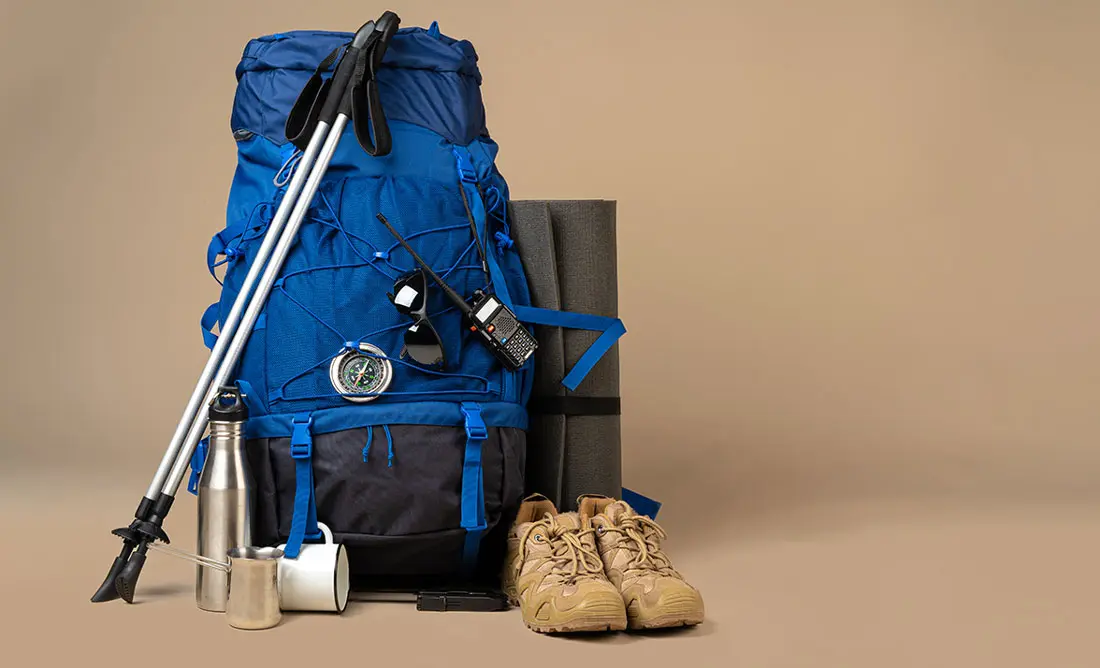
Frequently Asked Questions(FAQ)
To register with TTH, visit our website - www.trekthehimalayas.com and create your account. To create your account you will need to use your email address and fill in all the details, set your unique password and your account is ready to use.
- To book a trek with TTH, you first need to register with us and create an account.
- Choose the trek that you want to do and click on available dates.
- You will land at the login page, fill in the required details.
- Add Participants, choose add-on services click on the Pay now button, choose your preferred payment method, and make the payment. TTH accepts multiple payment options, including credit/debit cards, net banking, and UPI.
- You will receive a confirmation email from TTH with all the necessary details about the trek, including the meeting point, transportation, accommodation, and other important instructions.
- Click Here to watch Video
please send an email to us at info@trekthehimalayas.com or reach out to the numbers provided in the Help and Support section of your Trek Page. We will ensure that your issue is promptly resolved.
To book services such as off-load luggage and transportation, you can find them listed as add-ons. These additional services can be booked at the time of your initial booking. If you miss booking add-ons during the initial reservation, you can log in anytime and easily book 4 days before the departure date add-ons through the platform.
If you have booked the wrong trek or selected the wrong date, don’t worry! You can contact us at +91 9368882322 (Monday to Saturday, 10 AM to 10 PM) or email us at info@trekthehimalayas.com. You can also discuss this with your trek coordinator. Please make sure to inform us at least 10 days before the departure of your trek. Only then can we help you reschedule or arrange another trek for you.
We recommend visiting our "Suggest Me a Trek" page. By filling out the form, our experts will contact you with the best possible trek options based on your preferences and experience level. Alternatively, you can reach out to us via email at info@trekthehimalayas.com or give us a call using the numbers provided on our website for personalized assistance and recommendations.
Family treks differ from regular treks by focusing on ease of difficulty, offering shorter durations for younger participants, Kid-friendly and easily digestible foods, child-friendly activities, maintaining a higher guide ratio for diverse age groups, and implementing additional safety measures for families.
Family Trek with Kids recommendation Only Dayara Bugyal and Chopta Chandrashila Trek.
Minimum age for TTH treks is typically 7 years, though this may vary depending on the specific trek.
Yes, you can take a kids to a high-altitude trek with a parent. Discuss with a trek expert before booking a trek.
- Junior trekkers (below 15 years) should have a company of parents/guardians.
- Trekkers between 15 to 18 years can come solo with the disclaimer form signed by parent/guardian.
- Medical & Disclaimer Form (Mandatory Documents) Click here to download medical and disclaimer form
Physical Fitness: Ensure your child is physically fit. Engage them in regular exercise, outdoor activities, and hikes to build stamina and endurance. Hydration: Emphasize the importance of staying hydrated at high altitudes. Encourage your child to drink water regularly, even if they don't feel thirsty. Proper Nutrition: Provide a well-balanced diet with sufficient carbohydrates for energy and foods rich in iron to prevent altitude sickness. Adequate Sleep: Ensure your child gets enough sleep in the days leading up to the trek. Quality rest is crucial for altitude adaptation. Educate on Altitude Sickness: Teach your child about the symptoms of altitude sickness, such as headache, nausea, and dizziness. Encourage them to communicate any discomfort immediately. Appropriate Clothing and Gear: Dress your child in layers to adjust to changing temperatures. Ensure they have appropriate trekking gear, including sturdy footwear. Positive Mindset: Foster a positive mindset. Encourage your child, and let them know it's okay to take breaks when needed. Medical Check-Up: Schedule a medical check-up before the trek to ensure your child is fit for high-altitude activities. Consult with a healthcare professional about any potential health concerns.
TTH takes special care to provide wholesome and nutritious food for children on treks. Here are some of the foods that are typically served for children:
Breakfast: For breakfast, TTH serves a variety of options like porridge, cornflakes, bread, butter, jam, honey, boiled eggs, omelettes, and pancakes. Children can choose from these options to fuel themselves for the day's trek.
Lunch: For lunch, TTH serves lunch which includes rotis, vegetables, rice, dal, and salad. The rotis are usually made fresh on the trek and are a good source of carbohydrates. The dal and vegetables provide protein and other essential nutrients.
Snacks: TTH provides healthy snacks like fresh fruits, dry fruits, energy bars, cookies, and biscuits to keep the children energized throughout the day.
Dinner: For dinner, TTH serves a hot and wholesome meal which includes soup, rice, dal, vegetables, and a non-vegetarian dish (if requested in advance). Children can also choose from a variety of desserts like custard, jelly, and fruit salad.
Dietary requirements: If a child has any special dietary requirements, TTH can cater to those needs as well. For example, if a child is lactose intolerant or allergic to nuts, the kitchen staff can make arrangements to accommodate those requirements.
Choosing the right trek for a beginner can be a bit overwhelming as there are many factors to consider such as distance, elevation gain, terrain difficulty, weather, and time of year. Here are some tips that can help you choose the right trek for a beginner:
1. Determine fitness level: Assess the fitness level of the beginner to understand their physical capabilities. This will help you select a trek that is challenging but not too difficult.
2. Choose a well-traveled trail: A well-traveled trail will have more amenities such as signposts, water stations, and shelter. It is also safer as there will be other hikers on the trail.
3. Consider the length of the trek: For beginners, it is recommended to start with a shorter trek that can be completed in a day or two. This will help them get acclimatized to trekking and build their confidence.
4. Look for gradual elevation gain: Choose a trek with a gradual elevation gain rather than steep ascents. This will make the trek easier and more enjoyable.
5. Check the weather: Check the weather forecast before selecting a trek. Avoid treks during the monsoon season or winter when the trails can be slippery or dangerous.
6. Research the trail: Read about the trail to get an idea of the terrain, altitude, and difficulty level. This will help you select a trek that is suitable for the beginner.
7. Consult with an expert: If you are unsure about which trek to choose, consult our trek expert Mr. Nitin (+91 70600 59773) between 10 AM to 6 PM (Tuesday - Friday). Mr. Nitin will provide you valuable advice and guidance.
Overall, it is important to choose a trek that is enjoyable, challenging but not too difficult, and suitable for the beginner's fitness level and experience.
It is not recommended for a beginner to choose a difficult Himalayan trek. Trekking in the Himalayas can be physically and mentally challenging, especially if you are not used to the high altitude, steep slopes, and rugged terrain. Choosing a difficult trek without the proper experience, fitness level, and preparation can be dangerous and put you at risk of altitude sickness, injury, and other hazards.
If you are a beginner, it is recommended to start with an easier trek and gradually build up your skills and experience. This will help you understand the challenges of trekking in the Himalayas, and also prepare you physically and mentally for a more difficult trek in the future. It is also important to choose a trek that matches your fitness level, experience, and interest.
There is no specific age limit for a beginner trekker. However, it is important to consider your physical fitness, health condition, and personal interests before embarking on a trek. Trekking in the Himalayas can be physically and mentally demanding, and requires a certain level of physical fitness and endurance.
If you have any pre-existing medical conditions or are above a certain age, it is recommended to consult with a doctor before embarking on a trek. It is also important to listen to your body and take breaks as needed during the trek to prevent exhaustion or injury.
We recommend visiting our "Suggest Me a Trek" page. By filling out the form, our experts will contact you with the best possible trek options based on your preferences and experience level. Alternatively, you can reach out to us via email at info@trekthehimalayas.com or give us a call using the numbers provided on our website for personalized assistance and recommendations.
Yes, you can join the trek. We have fixed departure groups where you can simply book your trek and we will take care of curating a group.
Before you start the trek, it is recommended that you make all the necessary phone calls as during the trek you may or may not receive network coverage, once you come back to the Base Camp, you can reconnect with your family via phone once again. You can share your trek coordinator contact detail with your family members to get the latest updates about your trek batch.
At TTH, we provide wholesome and nutritious meals during the trek. The food is vegetarian and includes a variety of dishes such as rice, dal, vegetables, chapati, paratha, pasta, noodles, and soup. We also offer snacks such as biscuits, and salty, and dry fruits during the trek. Special dietary requirements such as vegan, gluten-free, or Jain food can also be arranged if informed in advance.
If you are allergic to some foods, you need to let us know in advance so that we can make arrangements accordingly.
TTH is a trekking company that prioritizes the safety of all its participants, including women trekkers. We have a comprehensive safety system in place, which includes a dedicated team of experienced and trained trek leaders and support staff who are equipped to handle emergency situations and provide first aid.
TTH also takes specific measures to ensure the safety and comfort of women trekkers. They have a separate tent accommodation for women trekkers, female trek leaders, and support staff. They also provide separate toilet facilities for women and encourage a safe and respectful environment for all trekkers.
Moreover, TTH has a strict policy against any kind of harassment and has a zero-tolerance policy towards such incidents. They have a designated Internal Complaints Committee (ICC) to investigate and address any complaints related to harassment or misconduct. Overall, TTH has a good reputation for safety and responsible trekking practices, and women can feel comfortable and safe while trekking with them.
In case you are the only women in the group, we provide a single sleeping arrangement. Also, during the trek, the trek leader will always remain by your side to provide optimum safety and reassurance.
You can reach out to the trek coordinator to inquire about the number of female trekkers and their respective states who have booked the trek. Please note that the trek coordinator cannot disclose personal details of any trekker. Once you've confirmed your booking, a WhatsApp Group will be created for all the trekkers in your batch. This allows you to connect with fellow trekkers before the trek begins.
While many of our treks are led by female trek leaders, however, it is not possible to know which trek leader is assigned to which group. But nonetheless, whether the trek leader is male or female you can be completely assured of your safety and security with us.
Yes, it is possible to trek with periods. However, it is important to take some extra precautions and preparations to ensure a comfortable and safe trekking experience. Here are some tips that can help you trek during your period:
1. Use menstrual hygiene products that you are comfortable with, such as tampons, pads, or menstrual cups. It is recommended to carry enough supplies for the entire duration of the trek.
2. Pack wet wipes, hand sanitizer, and plastic bags to dispose of used hygiene products.
3. Wear comfortable and breathable clothing that allows for easy movement and reduces friction. Avoid wearing tight or restrictive clothing that can cause discomfort.
4. Carry pain relief medication, such as ibuprofen or acetaminophen, in case of menstrual cramps.
5. Stay hydrated and maintain a balanced diet to support your energy levels and overall health.
6. Take breaks as needed and listen to your body. If you feel uncomfortable or experience any unusual symptoms, seek medical attention immediately. It is also recommended to consult with a doctor before going on a trek during your period, especially if you have a pre-existing medical condition or are taking medication.
By taking necessary precautions and being prepared, you can have a safe and comfortable trekking experience even during your period. We provide proper disposal facilities for sanitary pad disposal during the trek.
We offer three person tents with twin-sharing for optimum comfort. A woman trekker will share a tent with another woman trekker and if you are the only woman in the group, you will be given a single accommodation for your comfort and privacy.
Yes, we do provide gears on rent. You can book it using you TTH account directly.
Mountaineering qualified Experienced and first aid certified Trek Leader, First Aid Certify local guide, Cook, helpers and supporting staff.
People suffering from Bronchitis, Asthma, High blood pressure, Epilepsy (got faints), TB , Heart problem or on higher BMI side are strictly not allowed to go on any Himalayan trek. Apart from this if you had any medical history, please let us know.
No. Alcohol and smoking isn’t allowed while on trek. It is totally misconception that it will keep you warm. Your body need to acclimatize properly and for that eat properly and drink enough water; these things will keep you warm.
Toilet tents provide a convenient solution for answering nature's call in the great outdoors. Dry toilets, in particular, offer a highly sanitary approach. By digging a pit and utilizing mud and a shovel, you can easily cover up your waste. This method ensures cleanliness and hygiene while camping or exploring in the forest.
Remember to pack essential toiletries to complete your outdoor bathroom kit and maintain proper personal hygiene during your adventures. With these practices in place, you can enjoy nature while also respecting it.
Layer Up From Head To Toe
Eat Full Meals, never sleep empty stomach
You can keep warmee (if you’re more susceptible to cold).
Use sleeping bag in right way and don’t leave free space in sleeping bag.
For upper body
– Thermal layer
– T-shirt (full-sleeves)
– Fleece T-shirt (for extreme colds)
– Fleece layer
– Thick Jacket/Down Jacket
– Waterproof or Windproof layer (outermost layer, when it is snowing or raining)
- For Lower Body
– Thermal layer
– Hiking pants (normal) or Winter hiking pants
Based on how warm you feel you can skip any of the above layers. Your outer later should be windproof since it is windy at high altitude.
The idea behind layering is that the more insulation you have the less cold you feel, and instead of wearing a very thick jacket if you wear multiple layers, your body will be better insulated against the cold.
Yes, we provide micro spikes and gaiters, if required.
Mandatory documents: 2 xerox of ID having address (addhar card/driving license), 2 Passport size photographs, hard copy Medical form signed & sealed by doctor, disclaimer form sign by trekker and high altitude insurance.
No. We don’t but we can suggest you good hotel/Stay nearby pick up location.
Yes, trekker must carry 2 water bottles 1 litre each so they can refill it at campsite for drinking and keep themselves hydrate.
You should buy shoes which has these three features –Good grip, Ankle Support and additional water resistant layers. Generally, we advise Quechua Trek 100, MH 500 and MH 100.
No one is forced to go on. There is always enough staff to split the party according to need and regroup later at the camp. Most people have no trouble reaching the highest campsite. If some members decide not to climb the final distance they can wait for the climbers to come back down the same way or take a lateral path to the descent route.
No, Everest is much harder than Mount Kilimanjaro. Climbing Mount Everest requires technical mountaineering skills, use of oxygen cylinders, and weeks of acclimatization. Kilimanjaro, on the other hand, is a non-technical trek. It is challenging due to the high altitude, but does not need climbing gear or advanced experience.
The Machame Route is considered the most scenic way to climb Mount Kilimanjaro Trek. This route follows the "climb high, sleep low" principle, which helps your body adjust better to the altitude. It starts from the southern side of the mountain at Machame Gate near Arusha and ends on a different path near Moshi. Along the way, you’ll pass through different landscapes like rainforests, moorlands, and alpine deserts. It also has one of the highest success rates for reaching the summit.
Some of the toughest sections are the Barranco Wall and the summit day. The Barranco Wall looks scary but is more of a steep and manageable climb than a technical one. Summit day is especially hard because you start walking around midnight in cold, windy weather, and have to push through fatigue and thin air to reach the top. It’s long and tiring but worth it.
Mount Kilimanjaro is the tallest free-standing mountain in the world, which means it stands alone and not part of a mountain range. It’s also one of the Seven Summits, the highest mountains on each continent, making it a popular goal for trekkers worldwide. The fact that it doesn’t require mountaineering skills makes it even more unique and accessible.
On average, you will trek about 8–9 kilometers each day. However, the distance can vary depending on the day and the route. The toughest and longest day is the summit day, where you’ll walk around 16 kilometers in total, up to the summit and then down to the next camp.
The summit push begins around midnight so that trekkers can reach the top by sunrise, which offers an amazing view from Uhuru Peak. Starting early also allows enough time to return safely to a lower camp before weather conditions worsen. Trekking during the day under strong sun and at high altitude can lead to exhaustion and dehydration.
The water provided by the trekking team is treated and safe to drink. However, you should not drink water directly from rivers or streams on the mountain, as it might be contaminated. Since Kilimanjaro is a volcanic mountain, untreated water may carry harmful minerals or bacteria.
Yes, you need a visa to enter Tanzania, where Mount Kilimanjaro is located. Most travelers can get a visa on arrival at the airport or apply for one online before the trip.
To trek on Mount Kilimanjaro, you need a National Park entry permit. This includes several fees such as conservation fees, camping or hut fees, rescue fees, and more. When you trek with us, we take care of all the necessary permits and formalities, so you don’t need to worry about any paperwork.
You will need proper trekking gear to stay safe and comfortable across different weather conditions. This includes warm clothes for the cold nights, lightweight clothes for the lower regions, a waterproof jacket and pants for rain, snow protection like gloves and thermal wear, sun protection such as sunglasses and sunscreen, and a good pair of trekking boots. Also, carry dry-fit clothes to manage sweat and avoid cotton fabrics.
Yes, Kilimanjaro is safe for beginners. It’s a non-technical trek, which means no climbing gear or mountaineering experience is required. With proper guidance, preparation, and a gradual pace, many first-time trekkers, even kids and older adults have successfully reached the summit.
On average, it takes 9 days to complete the Kilimanjaro trek, including acclimatization and descent. Some shorter or longer versions are also available depending on the route, but 8 to 9 days is ideal for better altitude adjustment and summit success.
Yes, a beginner can definitely climb Kilimanjaro. You don’t need prior trekking experience, but basic physical fitness and mental determination are important. Many first-time trekkers reach the summit with the right guidance and preparation.
To prepare for Kilimanjaro, you should be able to jog 5 km in 30 minutes or walk 10 km in 70 minutes without feeling overly tired. If you prefer cycling, you should be able to cycle 18 km in about 50 minutes. Regular walking, stair climbing, and cardio exercises can help build the required stamina.
Mount Kilimanjaro stands at an altitude of 19,341 feet (5,895 meters) above sea level. It is the highest mountain in Africa and also holds the title of the tallest free-standing mountain in the world.
The total trekking distance on Mount Kilimanjaro Trek depends on the route, but on average, it is about 66 kilometers. This distance is covered over several days, giving your body time to adjust to the altitude.
We offer complete Kilimanjaro trekking packages that include airport pickup and drop, park permits, expert guides, porters, meals during the trek, stay in tents or huts, and emergency support. The package ensures your comfort, safety, and a high chance of reaching the summit successfully. Custom packages can also be arranged based on your group size and preferences.
Preparing for Mount Kilimanjaro requires a few important steps well in advance.
Book your flights early to get the best fares and ensure a smooth arrival in Tanzania.
Apply for your Tanzanian visa online or at the airport, depending on your preference.
Take the required vaccinations such as Yellow Fever (if coming from a Yellow Fever country), and consult your doctor for any additional recommended shots.
Arrange your trekking gear, either by buying or renting it. Make sure to have clothing for all weather types, cold, rain, and sun.
Focus on fitness, start training at least 6–8 weeks before your trek. Daily walks, jogging, stair climbing, and endurance workouts can help build stamina for long walking days at altitude.
Indian citizens need the following documents to apply for a Tanzanian e-visa:
A valid Indian passport (must be valid for at least 6 months after your arrival date).
A scanned copy of the passport’s information page.
A recent passport-size photo in digital format.
A return or onward travel ticket (digital copy).
A valid credit or debit card to pay the visa fee online.
An active email ID where your approved visa will be sent.
The visa process usually takes 7–10 working days, so apply in advance
The Kilimanjaro trek is rated moderate to difficult. While it doesn't involve technical climbing, the high altitude and long trekking days can be tough. The summit day is especially challenging due to the thin air and early morning start. With proper acclimatization, preparation, and a slow pace, most trekkers can complete it successfully.
Yes, beginners can definitely attempt Kilimanjaro. Many first-timers have reached the summit. While previous trekking experience helps, it's not a must. What matters most is good physical fitness, mental determination, and choosing a route with more days to allow proper acclimatization.
The Seven Summits are the highest peaks on each continent and represent a major achievement in mountaineering. They are:
Mount Everest – Asia (8,848 m)
Mount Aconcagua – South America (6,961 m)
Mount Denali (McKinley) – North America (6,190 m)
Mount Kilimanjaro – Africa (5,895 m)
Mount Elbrus – Europe (5,642 m)
Mount Vinson – Antarctica (4,892 m)
Puncak Jaya (Carstensz Pyramid) – Oceania (4,884 m)
To climb Kilimanjaro, you don’t need to be an athlete, but you should have good stamina and endurance. You should be able to:
Jog 5 km in 30 minutes without strain, or
Walk 10 km in 70 minutes without too much effort.
Alternatively, if cycling is your preferred activity, aim to ride 18 km in 50 minutes. Regular cardio workouts like walking, swimming, running, or cycling will help build your fitness gradually.
Mount Kilimanjaro stands at 19,341 feet (or 5,895 meters) above sea level. It’s the tallest mountain in Africa and the highest free-standing mountain in the world, not part of any mountain range, which makes it even more impressive.
The usual ratio is three local staff for each climber, although small groups may have four staff per climber. These usually consist of an English-speaking Chief guide, guides, a professional cook, and gear-carrying porters. We encourage you to interact with your staff, though some will have limited English. They are all trustworthy local people who have grown up in the shadow of the mountain. Many of them have climbed the peak 50 or more times.
The trek to Mount Kilimanjaro is not a technical climb, however, you require good physical condition to reach the summit. You should be able to walk for 2 hours on hilly terrains without getting overly exhausted. Anyone with a sore throat or cold should not go beyond 3000m/ Anyone with heart or lung problems cannot be reconciled on the expedition.
You will simply carry a daypack of about 10-15 kg, though some people carry more or less. Your gear, not to exceed 15kg, will be placed inside a waterproof duffel at the trailhead, and a porter will carry this for you. If you have things you do not need on the climb, you may leave a bag behind at Arusha.
